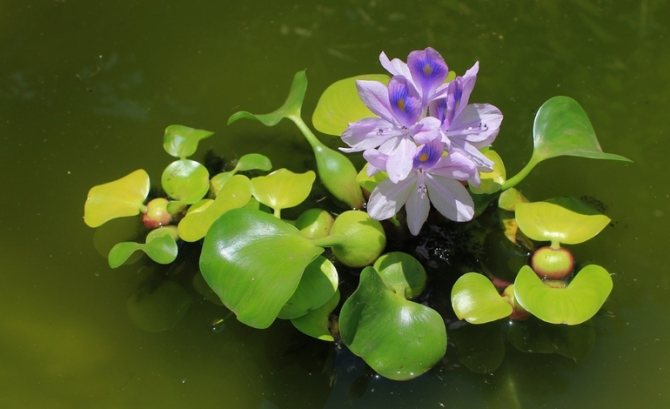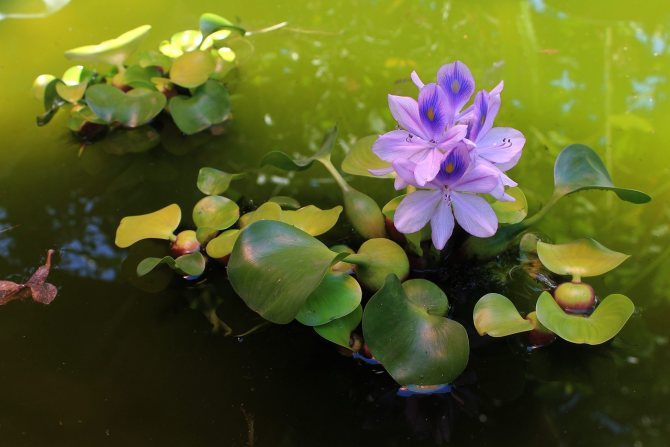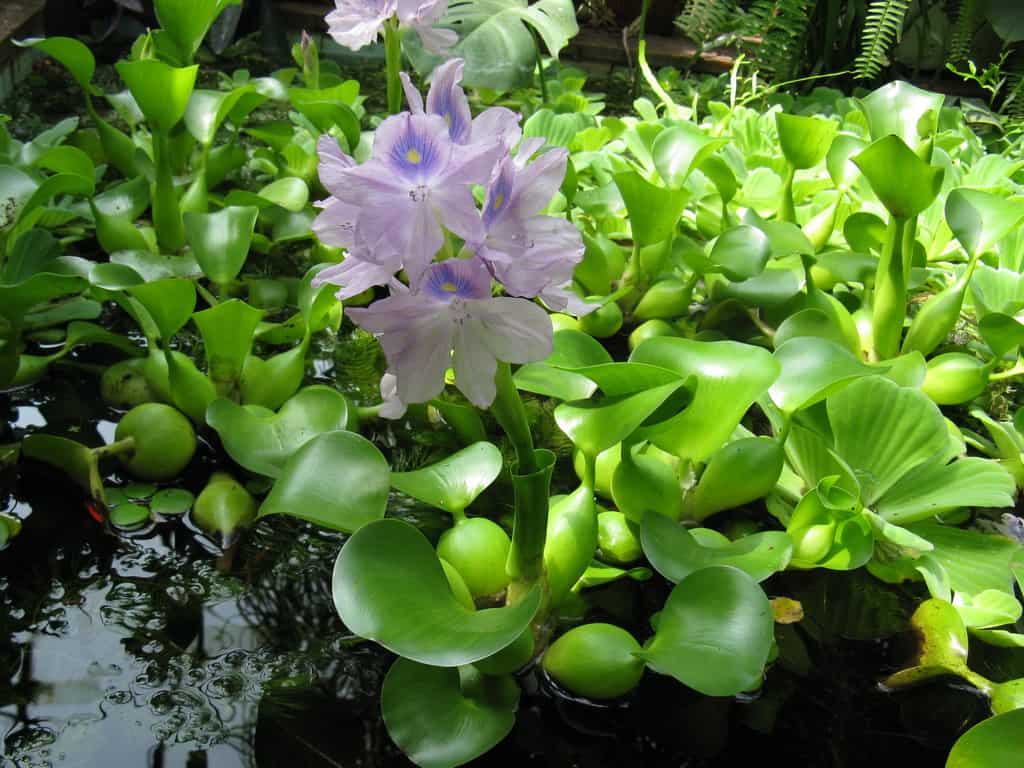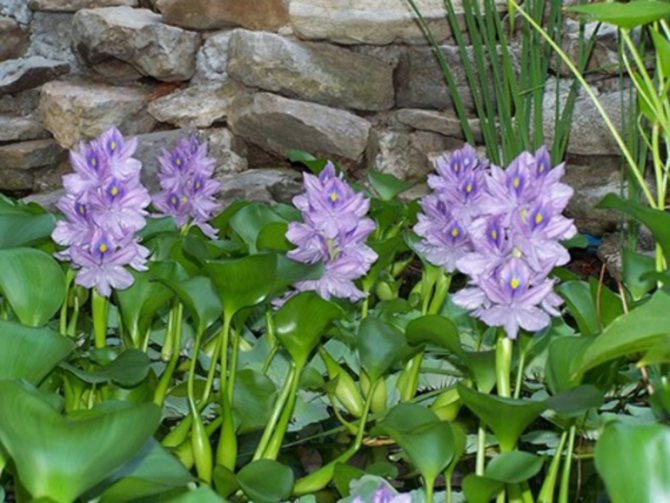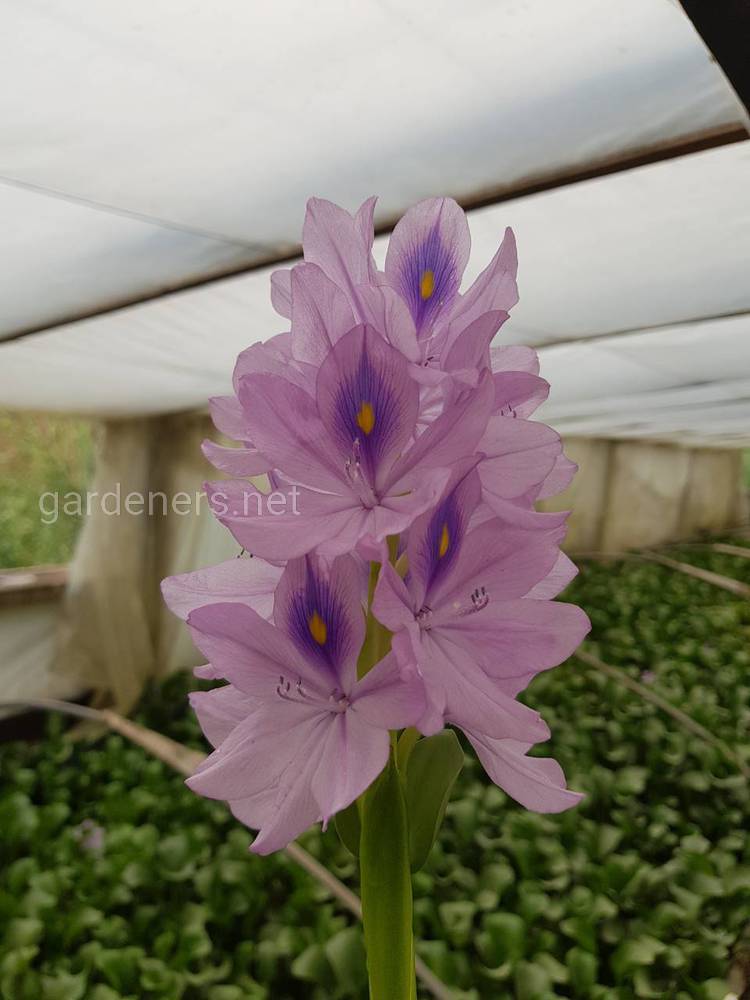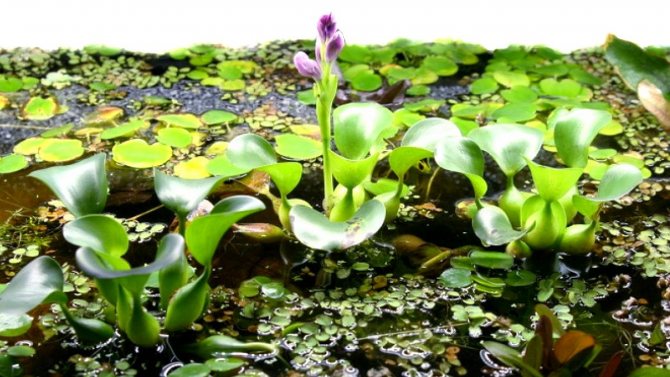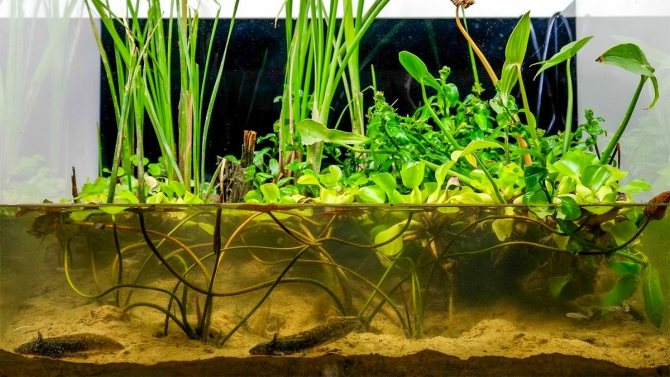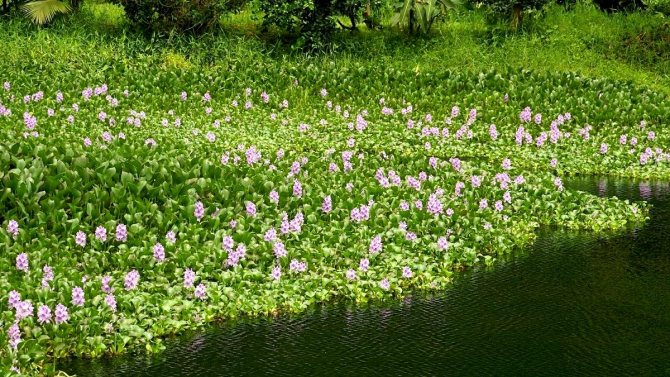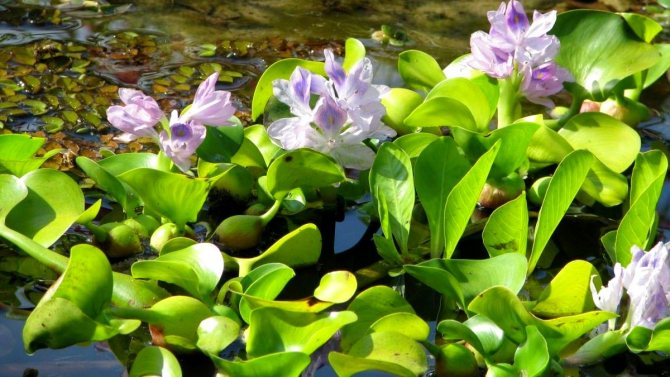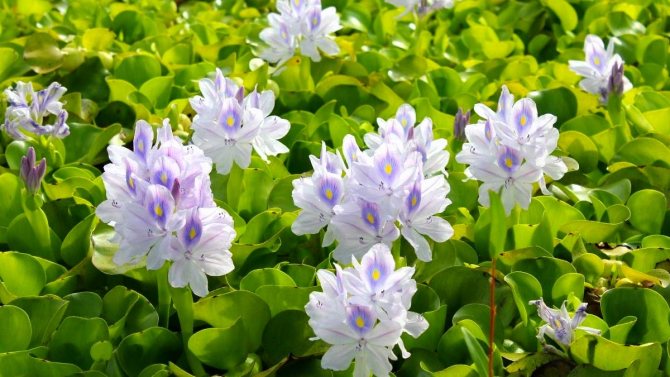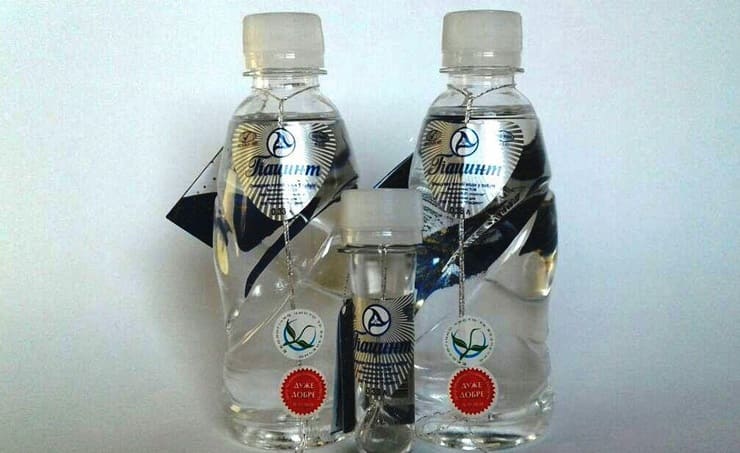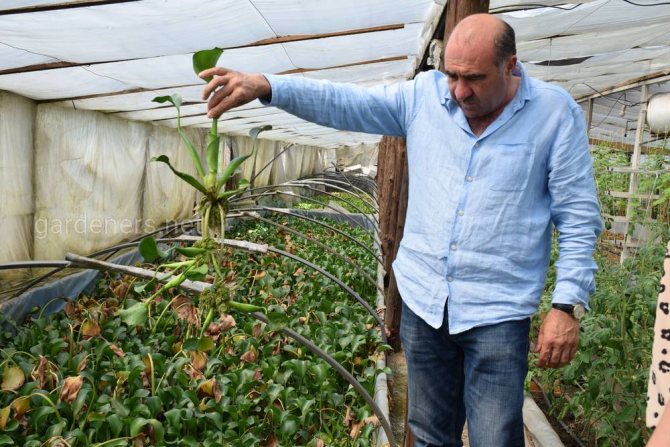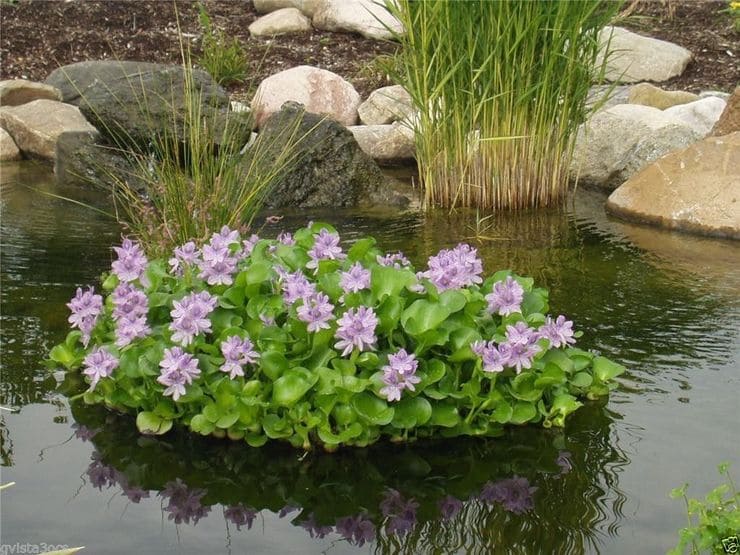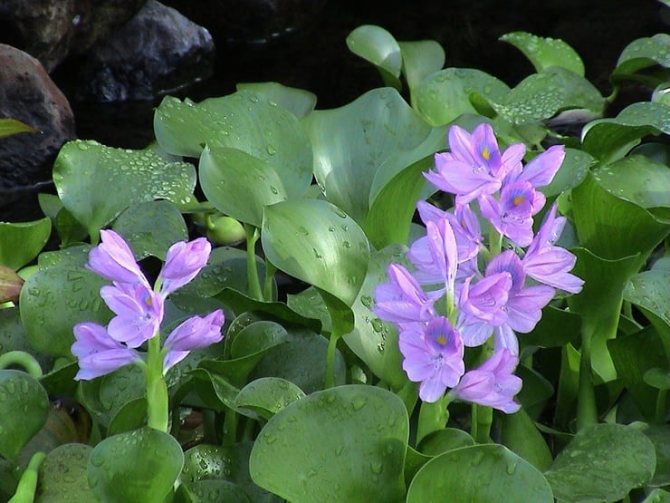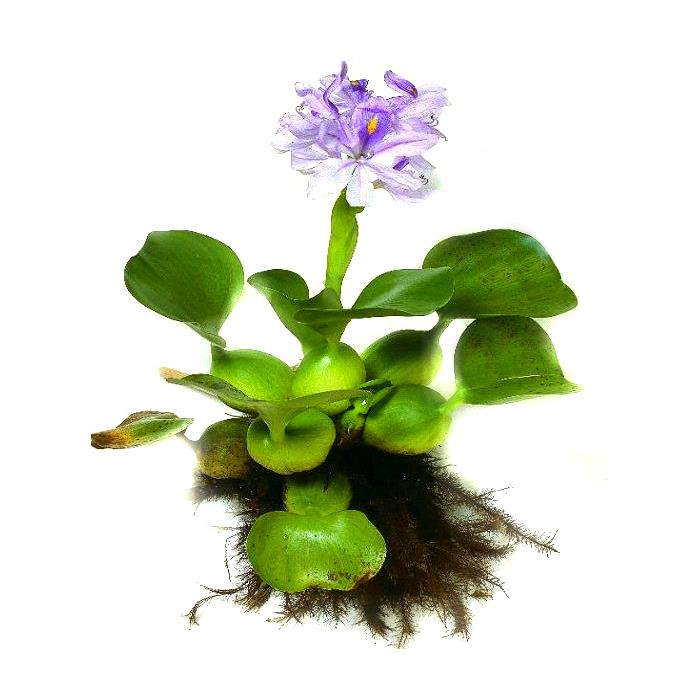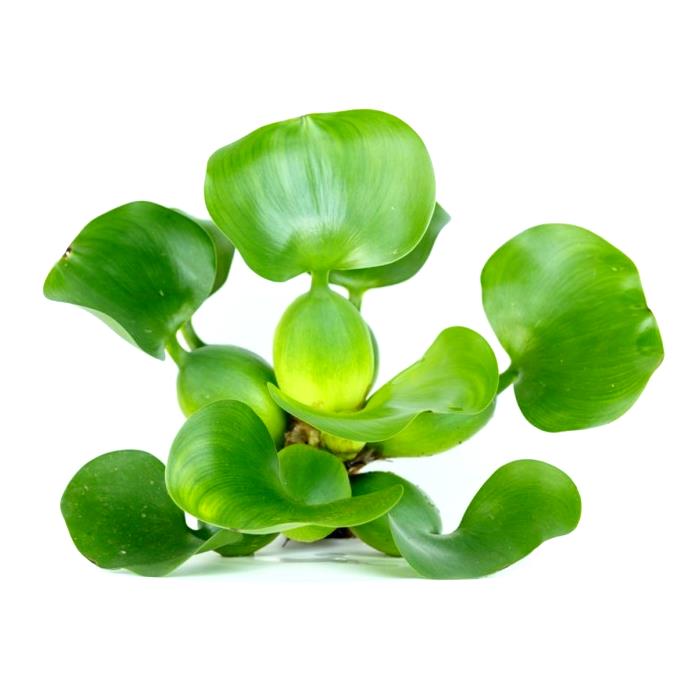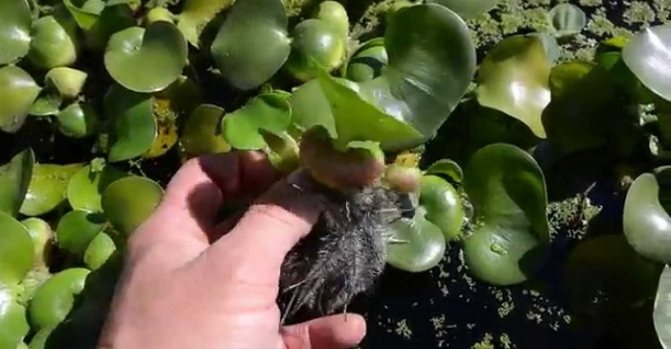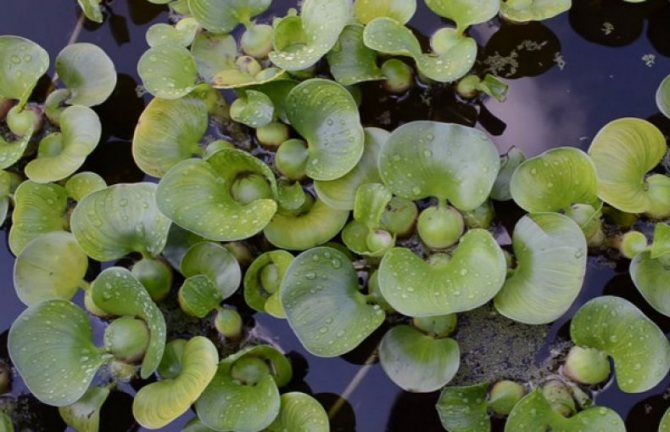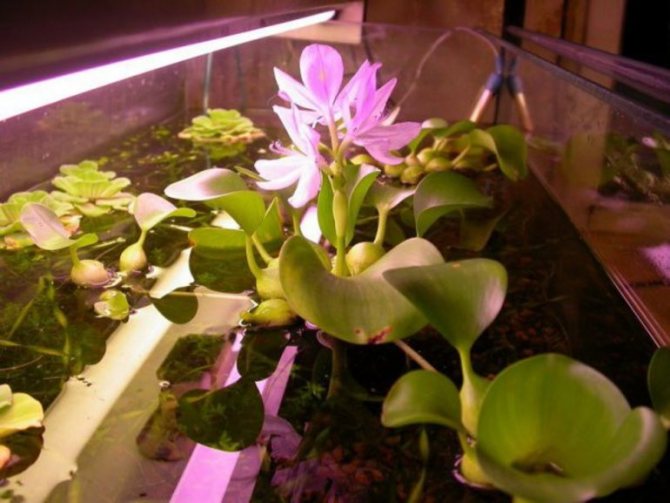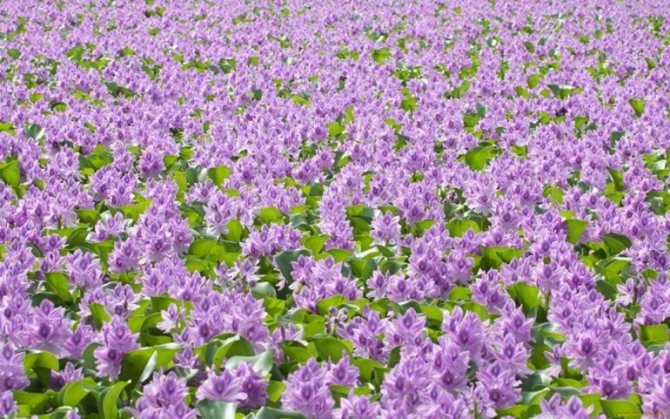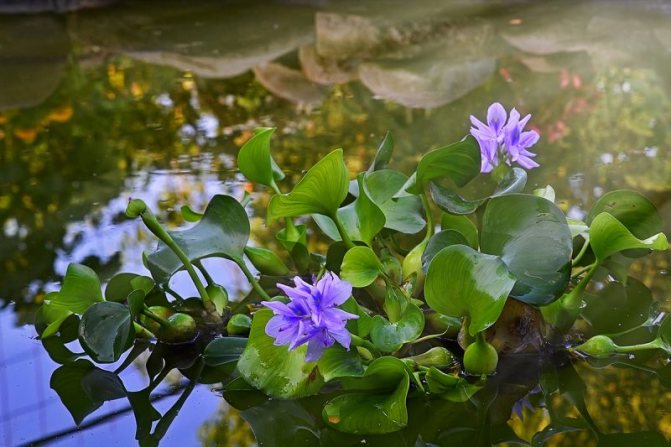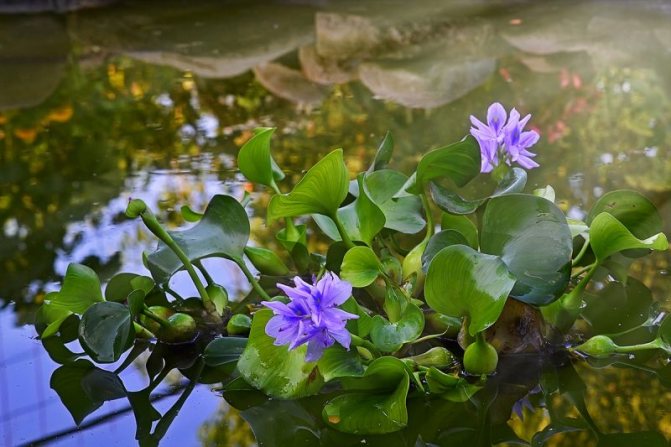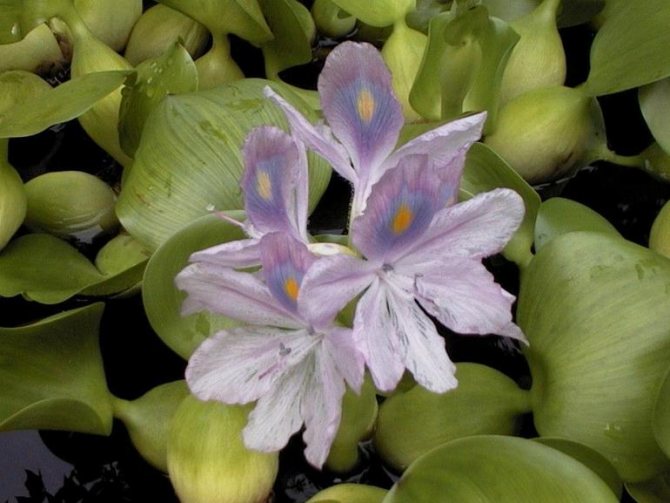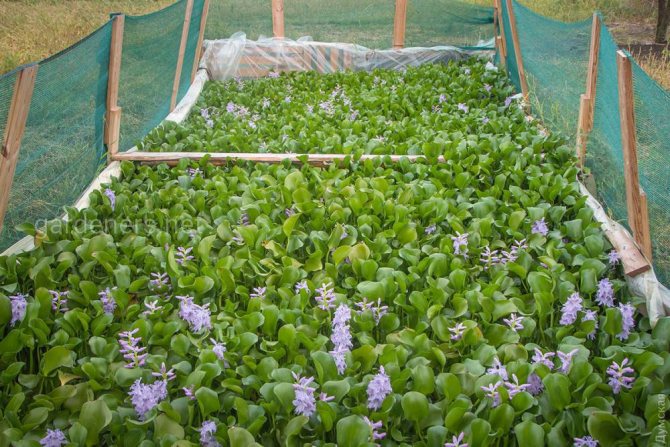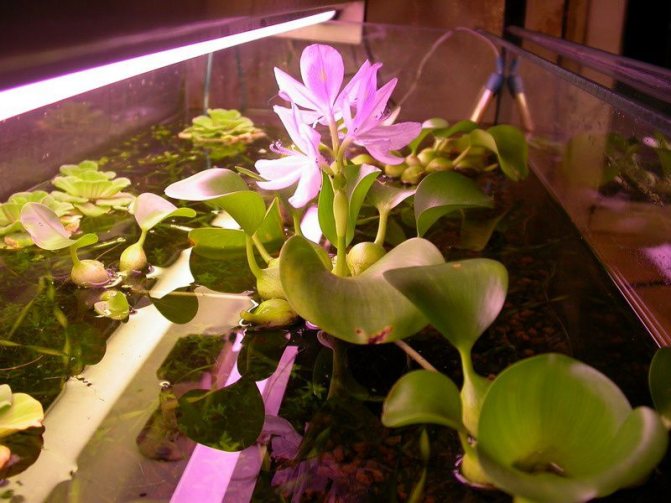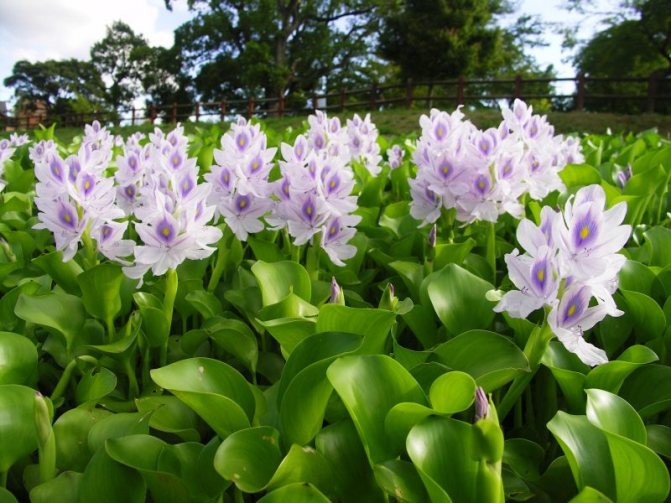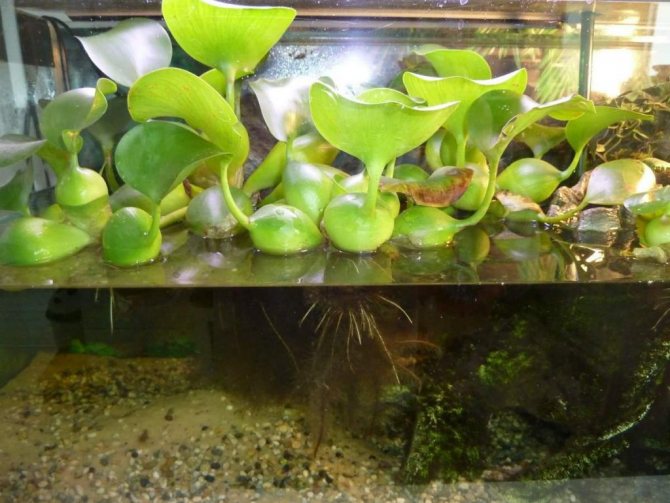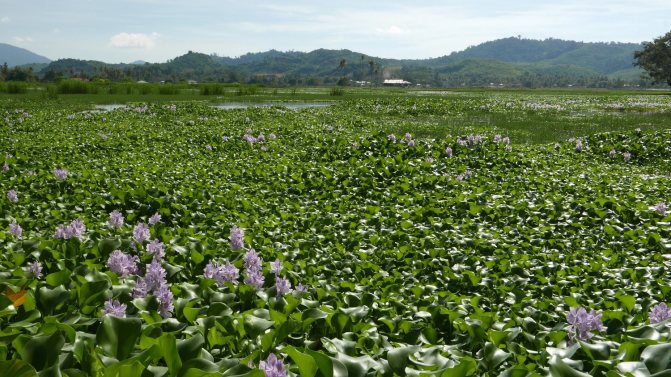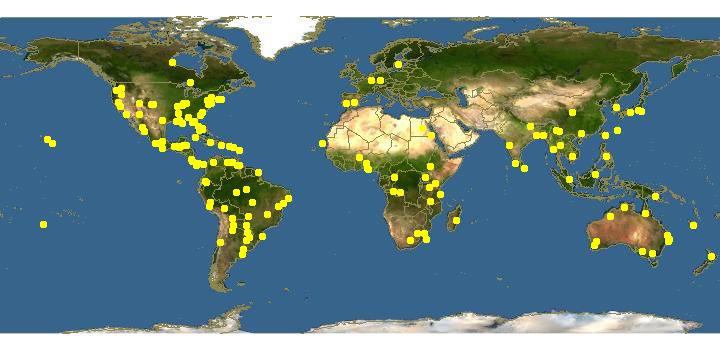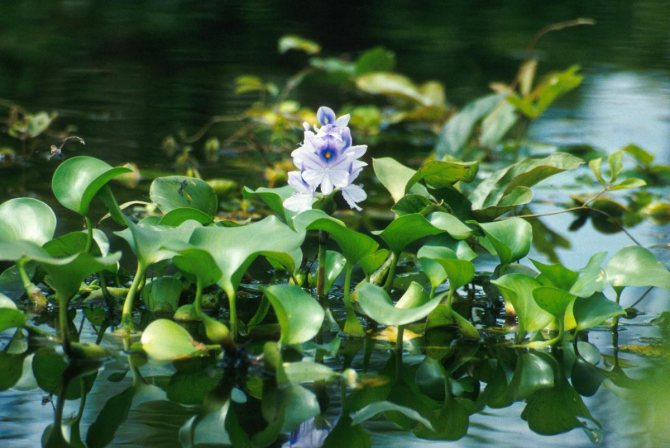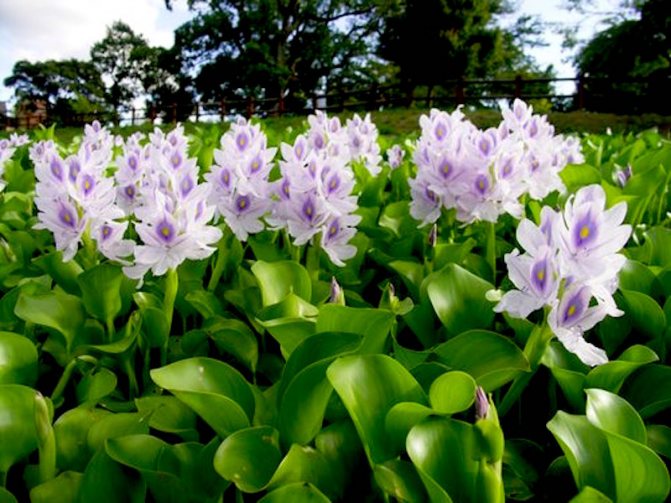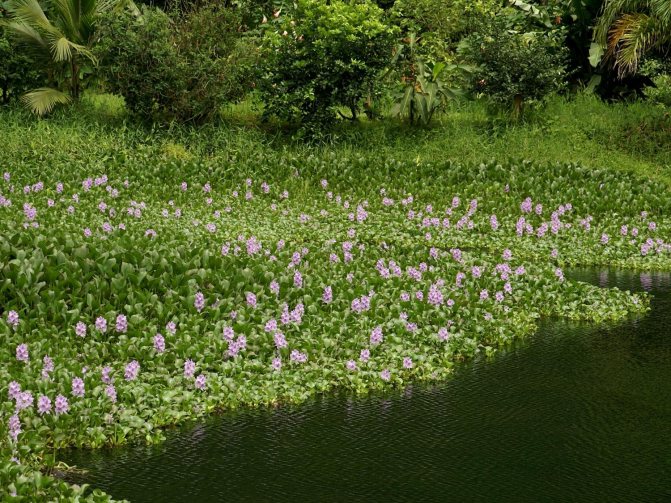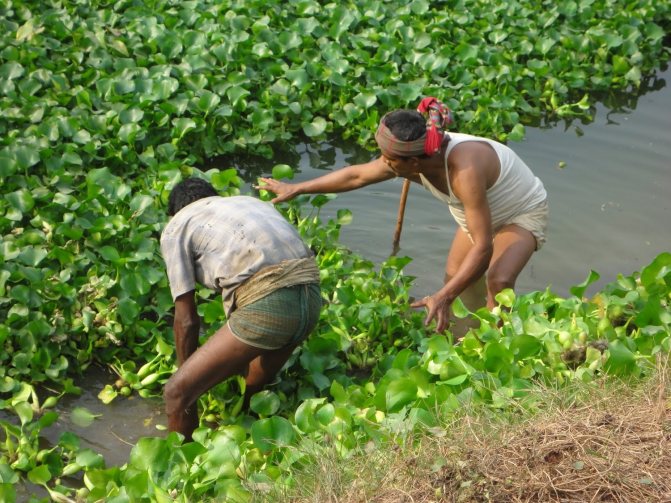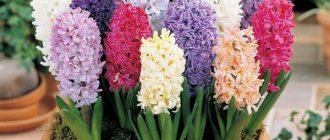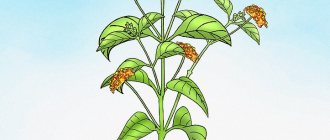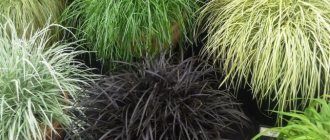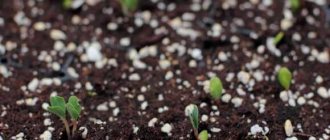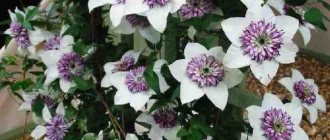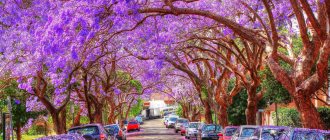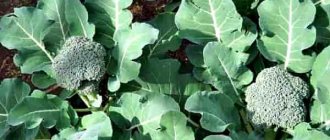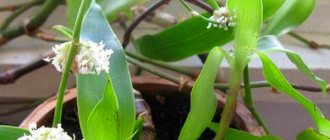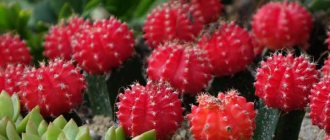Garden ponds and home aquariums create a beautiful and original interior. If you add beautiful flowering plants to them, the design will become even brighter. There are many ornamental grasses, flowers and shrubs. Among all this abundance, water, or water, hyacinth stands out - it is not at all difficult to grow it at home.
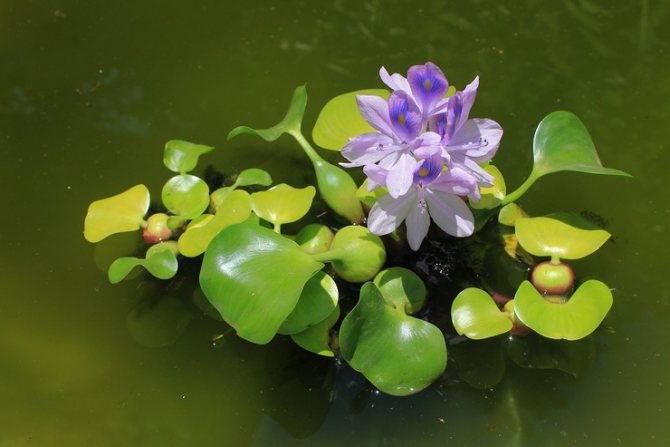
Water hyacinth is ideal for home ponds
Description
Water hyacinth (Eichhornia crassipes) is an aquatic plant native to the tropical regions of South America. It is also called excellent eichornia. The natural environment for a flower is lakes, rivers (with no strong currents), ponds, swamps and even ditches.
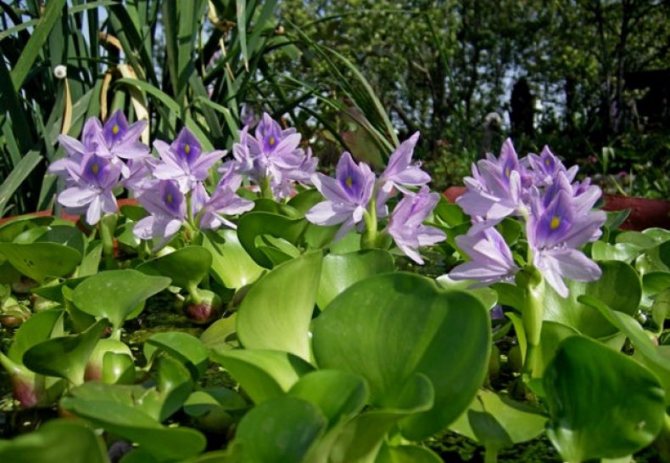

The stem usually reaches 10-15 centimeters in height and produces approximately 10-15 flowers. In the natural environment, it can grow up to one meter, and in the aquarium, the water hyacinth, of course, will be much smaller. Large flowers, reaching a diameter of 20-30 millimeters, the gamut can vary from pale pink to deep lilac hue. Because of the magical appearance and pleasant fragrant aroma of inflorescences, eichornia is called beautiful. In a European climate, the plant is likely to please with color in the spring and summer season.
Where the first eichornia thickets were discovered
Initially, Eichornia thickets were found in the floodplains of the Amazon and Ganges rivers. Back in the 80s of the last century, in the countries of the tropical zone, this plant was called a malicious weed and they fought with it. But today, in many countries with different climatic conditions, a set of programs for cleaning and revitalizing with the help of hydro-macrophytotes has been developed and is constantly being improved, including eichornia, lakes, small rivers and reservoirs, which are listed as dead due to industrial or domestic pollution.
Features of planting and growing
Eichornia is excellent - it is an incredibly demanding and capricious plant, so the conditions of its planting and care should be approached responsibly. As a decorative species, water hyacinth can be grown in a pond or in an aquarium: the specificity of the process depends on the chosen conditions.
In the pond
When growing eichornia in a pond, the main task will be to create conditions that will be close to its natural ones. This is primarily warm water rich in organic matter and vitamins. It would be good to add humus, prepared bottom silt or compost to it. This culture is able to quickly decompose substances, therefore, various harmful agents inherent in the pond are not afraid of it. That is why you do not need to pre-clean the reservoir before planting. If possible, it is worth choosing water with a slightly alkaline reaction, but this is not the most important factor. An important condition for growing water hyacinths is the temperature of the water and the environment in general. The fact is that at home, culture develops at + 24-30 ° C. The plant loves the sun and requires constant lighting. Planting should be started in May-June, so that the hyacinth has time to take root and grow before the cold weather. In addition, at this time the greatest amount of solar heat and light. Eichornia excellent is difficult to tolerate temperature changes, so this indicator should be stable.
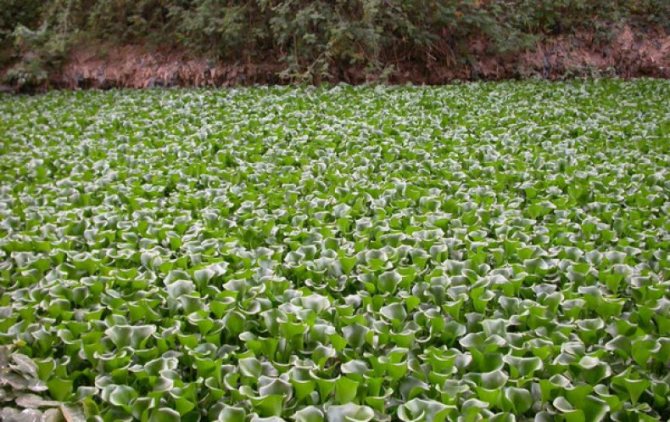

In aquarium
Keeping eichornia in an aquarium has several features. On the one hand, it is much easier to control the temperature; there are a huge number of devices and devices that heat the water in the aquarium if necessary. On the other hand, there are several difficulties in this type of cultivation. Firstly, the container should be far from small, because the plant will develop poorly and may die from lack of space. Secondly, you need artificial light for the hyacinth, and you need a lot of it. Experts advise fluorescent lamps with a power of 3.2 watts or more. It will also be good to rearrange the aquarium on the windowsill, then your pet will certainly bloom in our latitudes.
Diseases and pests
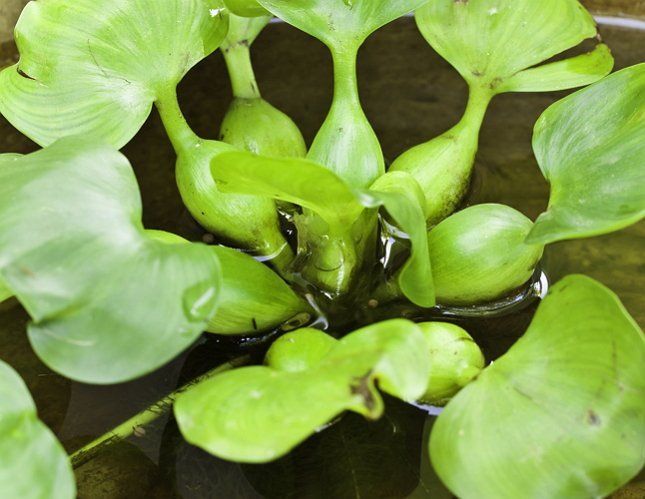

This plant is distinguished by good health and its diseases are solely the result of improper maintenance or care. As for pests, the danger for hyacinth is mainly the weevil beetle. But even this pest will not be able to cause any tangible harm to the plant.
Pay attention to the appearance of the plant. If suspicious dark spots appear on the leaves, this may indicate a hyacinth cold due to drafts or lack of fresh air.
If the spots have multiplied and acquired a dark brown tint, this symptom may indicate root rot. Putrefactive processes can be prevented by placing plants on special float rings that will keep the hyacinth above the water surface.
The plant does not tolerate drafts and gusts of wind. Therefore, in order to exclude such a negative impact, it is recommended to plant some bushes or tall plants tightly along the banks of the artificial pond.
So, we got acquainted with an amazing plant - water hyacinth. Of course, growing it in our cold climate is fraught with difficulties - after all, the flower has a tropical origin and is very thermophilic. However, if you can meet all the conditions, then you will get a wonderful decorative decoration of a pond or aquarium.
Reproduction
Reproduction of water hyacinth at home is quite possible and easy to do. Experienced botanists say that this process is very similar to the reproduction of the well-known strawberries. The plant has daughter processes. This means that eichornia is able to reproduce vegetatively. A similar procedure takes place at an incredibly fast pace - more than 100 new plants can appear within a month. As soon as the daughter process has several leaves, it can be safely removed from the main hyacinth.
When caring for a crop, it is worth maintaining the desired temperature (from + 24 ° C). In the region of + 10-20 ° С, the plant may not bloom, but it will "live". Eichornia needs about 14 hours of daylight.
When grown at home, water hyacinth also requires frequent pruning. Do not forget about this in the aquarium, otherwise the fish will not get along with this plant.
If the excellent eichornia multiplies too quickly, then its bushes need to be constantly done less often so that there is some distance between them. If you notice that the plant has become a little "lifeless", provide it with additional light and oxygen as soon as possible.
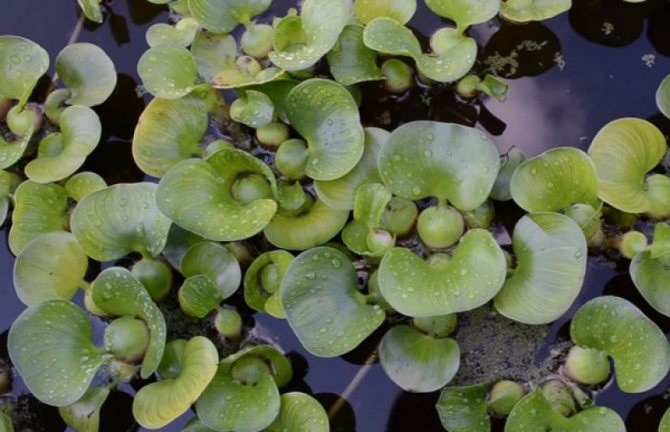

Breeding features
In nature, the flower multiplies without any difficulty, easily and quickly. But even in artificial conditions, reproduction is also not a very difficult procedure. There are opinions that this process is very similar to the reproduction of garden strawberries with a mustache: water hyacinth also multiplies with the help of daughter processes.
Under favorable conditions in summer, the water hyacinth increases its population at an unprecedented rate, forming up to 100 new young plants a month. You can help him by plucking a daughter process from the mother bush in time and transplanting the latter to another place.
If you don't have your own hyacinths yet, seed reproduction is also possible. But this procedure is fraught with difficulties, the main one of which is to ensure the seeds are kept for a long time at a temperature of +35 degrees.
Wintering
Water hyacinth is very light and heat-loving, so wintering becomes a huge stress for it. During this period, he needs special care and attention, which consists in the following actions:
- when the temperature drops below + 15 ° С, the plant from the pond must be removed into a container with "native" water and brought into the room;
- provide additional light (at least 10 hours a day);
- monitor the stable water temperature, which should be above + 20 ° С;
- control the supply of sufficient oxygen;
- protect the plant from drafts;
- place the hyacinth on the ring float;
- humidify the air in the room;
- fertilize the plant, since minerals are especially important in cold weather.
The container with eichornia must be located as far as possible from the heating system in order to avoid drying out. Do not cover the container with the plant or remove it from the water. This is deadly for the Eichornia.
How water hyacinth winters
Heat-loving Eirhornia will not tolerate temperatures below 0 degrees. To preserve the plantings until next season, you will need to move them to a warm environment. Winter storage can be carried out in an aquarium or other transparent container, at the bottom of which sand or silt will be placed.
For a successful wintering of a water hyacinth, the following rules must be observed:
- maintain the temperature of the water in the quarantine container at the same level as in the permanent habitat of the flower;
- place fertilized soil at the bottom of the container so that the roots of the plant can properly feed;
- feed the plant regularly.
It is advisable to organize backlighting for plantings for 12 hours a day. But if this is not possible, it is enough to place a container with water hyacinths on the windowsill on the south side of the house. And after stable warm weather is established, it can be moved to its native reservoir, where it will quickly grow deciduous mass, and by the end of summer it will throw out a peduncle.
In winter, Eichornia should be moved to a warm place.
On a note. If the region where the Eichornia grows is mild and not frosty, it will winter well in a greenhouse, placed in an ordinary water barrel.
Application in landscape design
That is why eichornia is beautiful to be widely used to create gorgeous landscapes. This reminder of warm America and the tropics is common in landscape design all over the world. The delicate color and cute hyacinth leaves in the pond are a great addition to the garden. In the aquarium, the plant will turn into a colorful spot that will blend in harmoniously with colorful fish and shells. The main thing is to constantly monitor this inhabitant of your reservoir and limit its growth so that there is not too much hyacinth. Let the excellent eichornia become a useful plant and please your eye!
The water hyacinth or eichornia is excellent - a herbaceous aquatic plant with a rosette of rounded green leaves and beautiful flowers. Homeland of Eichornia South America. In hot tropical climates, the plant grows rapidly, covering the surface of water bodies. In addition to its decorative appeal, water hyacinth has practical applications. Its root system absorbs harmful substances and heavy metals dissolved in water.
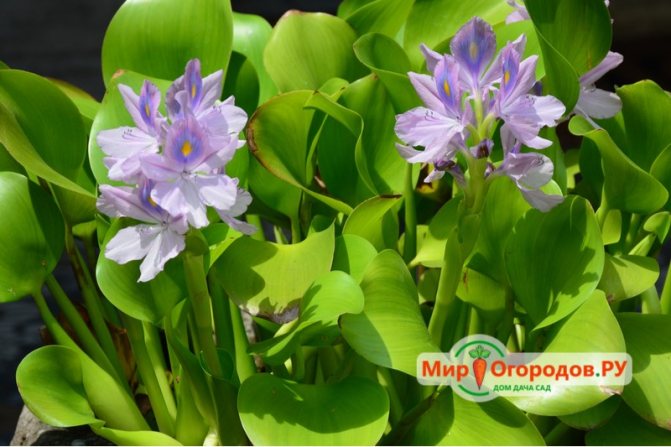

When does water hyacinth bloom in nature?
In Asia and South America, hyacinths grow at an air temperature not around +26 ° C. In the middle lane, such warm periods are not frequent. Flowering begins at +28 ° C and stops already at +22 ° C. Therefore, to the north of the Chernozem region, it is difficult to achieve an annual flowering of an aquatic culture.But the closer to the south, the more actively the water hyacinth blooms in ponds and other bodies of water.
If the summer is cold, a cap of rich green foliage grows magnificently over the water. For cultivation in a pond, water hyacinths are planted in May or June, when the water is already warmed up enough and there is no risk of cold snaps.
Botanical description
Eichornia excellent or thick-legged (Eichhornia crassipes) belongs to the Pontederia family. These are monocotyledonous plants common in the subtropical and tropical zones. Water hyacinth is an annual, creeping along the surface of the reservoir with shoots up to two meters long. Glossy fleshy leaves form a rosette, 4-8 pieces. They are curved, somewhat narrowed towards the apex, the edges are even. Longitudinal veins are clearly visible.
At the base of the leaves, a spherical or ovoid swelling with a diameter of 4-9 cm is observed. If the cutting is cut in a wide area, the porous middle is visible. The spongy tissue is filled with air, which prevents the plant from completely submerging. Unique floats keep large leaves and flowers on the surface. With a massive accumulation of outlets, the swelling decreases in size.
Information. The water hyacinth eichornia originated in Brazil. Under natural conditions, it is found in the tropical areas of the Amazon. From South America, the aquatic flower has spread to Africa and Asian countries.
The fibrous branched root is completely submerged in water. It is black in color, grows up to 50 cm long. In shallow water it takes root in a muddy bottom, in the middle of the reservoir it swims freely. Flowering begins in August. The spike-shaped inflorescence resembles an oriental hyacinth, hence the second name of the plant. There is no relationship between an ornamental flower and an aquatic plant.
A simple perianth has six petals. In diameter, they grow up to 6-7 cm. On one peduncle there are up to 35 flowers, but on average about 5-7. When ripe, a multi-seeded capsule 1.5 cm long is formed. It opens, throwing the seeds into the water. In hot tropical waters, they germinate, giving life to a new plant.
There are blue and lilac eichornia. The photo shows what an interesting pattern covers the upper middle petal of the water hyacinth. You can admire this miracle only for one day, then the stem falls into the water. On a sprawling plantation, flowers bloom continuously, so the process looks amazing.
Interesting fact. Large curved leaves help eichornia beatiful to settle in new places. They, like sails, carry a rosette over water bodies.
Reproduction
Water hyacinths reproduce vegetatively. Processes (whiskers) are formed, like those of a strawberry. At the end, a new rosette of 4-8 leaves is formed. The process is proceeding with great speed, especially under favorable climatic conditions. Growing water hyacinth from seeds is not practiced. In our climatic zone, they do not have time to ripen, it is much easier and safer to propagate the plant vegetatively.
How did a beautiful tropical plant turn into a green plague?
The history of the distribution of water hyacinth was not without a curiosity. Now this beautiful plant is known all over the world, as it grows in the natural environment of the tropics and subtropics of all continents. But the very process of its spread almost ended in a real ecological catastrophe!
1884 year. Cotton Show in Texas. To revitalize the interior, the organizers of the event set up an artificial reservoir with an unknown beautiful plant floating in it. It attracts everyone's attention with a harmonious combination of emerald green leaves with delicate lilac inflorescences.
To attract visitors to the exhibition, a massive sale of outlandish plants is started. Satisfied with the successful purchase, people dispersed to their estates, where from that very moment they began to breed Eichhornia crassipes in pools and ponds.The process proceeded rapidly: eichornia multiplied quickly in comfortable conditions, and its owners distributed children to everyone.
Surplus copies were sent directly to nearby bodies of water. Soon, a delicate aroma could be felt everywhere and delicate inflorescences of hyacinths could be seen.
However, quite quickly, general admiration was replaced by anxiety - the rapidly multiplying plant created a real threat to rivers, ponds and other bodies of water. It took just a couple of months for each plant to create up to a thousand of their own kind, which, in turn, began to divide, forming new specimens.
Gradually, these aliens began to conquer more and more water areas. And only now came the realization of what the thoughtless actions of a person who transferred the plant organism to conditions devoid of natural enemies in the form of pathogens or insects can turn into for nature.
So the handsome hyacinth from an ornamental plant turned into a green plague, a weed that inhabited reservoirs and:
- obstructed navigation;
- interfered with fishing;
- did not allow birds to settle in familiar places;
- dammed canals for irrigating the land, threatening entire peasant villages with starvation.
The green plague has done a lot of trouble, filling the reservoirs of Africa, Asia, Australia, before it was possible to cope with it. Science came to the rescue - it was decided to bring insects that feed in the natural environment on the leaves of this plant to the places where the eichornia is spread. So the fatal mistake was corrected.
However, this negative experience was not in vain. He made people look for an immoderately propagating plant on their own. And it was found. Water hyacinth began to be used as:
- livestock feed;
- fertilizer;
- raw materials for the production of paper.
The eichornia plant is a water hyacinth that lives in warm tropical waters. For the rivers and lakes of Africa, Asia and South America, where the climate is suitable for it, Eichornia sometimes becomes a real disaster. The warm environment encourages the growth of the culture and it is able to completely fill the reservoir, leaving no chance for the sun's rays to break through. For this she was nicknamed "the green plague."
The plant does not live in colder water, so here you can meet this beauty only in artificial reservoirs, aquariums and ponds. Thanks to the fragrant flowers of very delicate shades from white and blue to lilac, beautiful leaves of a juicy green color, it has rightfully become an adornment of water landscapes. The unique properties of the plant as a natural filter are also appreciated. It was found that the plant is capable of absorbing radioactive heavy metals and radionuclides from water bodies. Eichornia is also used for the purification of industrial effluents from oil products and at livestock treatment facilities.
Water hyacinth has nothing in common with garden hyacinth and does not belong to this family. The similarity of the peduncles with the garden hyacinth is also determined by the name.
Eichornia is a plant that lives exclusively in tropical waters rich in organic matter. In the tropics, water hyacinth blooms almost all year round.
Eichornia blooms very beautifully. The flower, shaped like an orchid, forms on a peduncle in the center of the rosette. One stem can have up to 12 flowers with delicate light purple petals. But the water hyacinth blooms for a very short time, after a day the plant is pollinated, and the seeds ripen and fall into the water. In the tropics, seeds instantly begin to germinate, but in temperate climates this does not happen, since this requires a water temperature above +26 degrees, and an air temperature of +35. Therefore, reproduction in the middle climatic zone occurs only vegetatively.
Eichornia leaves are arranged in a special way, so it does not sink in water, but can float on the surface. The peculiarity lies in the fact that its sheet resembles a sponge.It consists of many cavities that are filled with air. Therefore, no matter how deep the body of water falls to it, the plant will float on the surface. It is the roots of the plant that serve as a filter for water, absorbing all chemically hazardous contaminants, phenols, insecticides. A very useful quality for fish farms and stocked reservoirs. But here it is necessary to ensure that the eichornia does not grow too much on the surface, since this can deprive the fish of oxygen.
If the depth of the reservoir is small, then the plant will take root in the ground.
The body of water in which the water hyacinth grows affects the shape of the plant. In a quiet pond with calm water, eichornia will grow with long and slender stems, but if the water has movement, then the plant will turn out with thick petioles.
Planting and care in the pond
Water hyacinth is not such an exotic plant for the reservoirs of central Russia. It takes root well in artificial and natural ponds. Planting and caring times for water hyacinths depend on the climate in the region. In the south, it is lowered into water bodies in May, in more northern latitudes in early June. The main conditions for its development are high temperature, prolonged illumination, a sufficient amount of organic matter and dissolved minerals. If the first requirement is beyond the control of people, then the rest are easy to fulfill.
For a young plant bought in a store, any body of water in an open area is suitable. Artificial ponds are often filled with fish and algae. With such a neighborhood, an excellent eichornia will always be provided with food. At the same time, it purifies the water in the pond.
In a clean reservoir, the plant has nothing to eat. Fertilization will be required:
- bottom silt;
- complex mineral supplements;
- humus.
Nutrients are especially important in spring, during the summer, plants and insects fall into the water, creating a breeding ground. Care consists in periodically cutting off the overgrown shoots. The water hyacinth should not cover more than 60% of the water surface.
Attention. The slow development of rosettes and the pale color of the leaves indicate a lack of nutrients in the reservoir.
In cold summers, the water warms up slightly, so the water hyacinth does not bloom. But the juicy dark green foliage of a rounded shape looks decorative.
Growing conditions
The most important point in the technology of growing hyacinth is to know how to preserve it in a watery winter, because there is no winter cold in its homeland. In an area with an unsuitable climate, human intervention is necessary so that the eichornia does not die. Otherwise, planting and caring for a water hyacinth does not pose any particular difficulties. If you plant a plant in a summer pond, the main thing is that the weather is sunny. Hyacinth propagates like strawberries - by lateral shoots. But growing water hyacinth eichornia at home requires special knowledge and skills. There must be an appropriate temperature regime and special soil, because it is these two factors that determine whether you can grow hyacinth at home. But the flower will benefit your home aquarium, not to mention aesthetic pleasure.
How to preserve water hyacinth in winter
Subzero temperatures do not allow eichornia to be left in open water during the cold season. How to preserve water hyacinth in winter? This can be done in two ways: by placing it in a container with peat or in an aquarium. In the first case, a young rosette is taken and placed in a pot of wet peat. The container is placed in a tray, where water is always poured. Instead of peat, a 1: 1 mixture of garden soil with sand is used. The plant is placed in a warm place with good lighting. A south-facing window will do.
For wintering at home, it is recommended to leave a plant with a root of no more than 10 cm.It must be healthy, then the chances of keeping it up until the beginning of summer increase. Not always the conceived succeeds, what reasons lead to the death of Eichornia:
- The plant was not transferred to a warm room in a timely manner. Cold night temperatures, in the region of 10-8, could lead to water hyacinth disease. The frozen plant darkens and rots.
- The leaves dry, starting from the bunks from too dry air in the apartment. A tropical flower requires not only high temperature but also humidity. Covering the container of pots with plastic wrap with holes for ventilation will help ensure the right conditions. The aquarium is covered with a glass lid.
Advice. Leave free space between the leaves and the shelter, they should not touch the cover.
- Insufficient water volume and poor nutrition lead to the death of the plant.
- Failure to comply with the recommendations for the temperature of the content and the duration of daylight hours.
- A sharp change in temperature, exposure to a draft.
Expert and practical work on the efficiency and safety of using eichornia
For more than a hundred years abroad, expert and practical work has been carried out to control the effectiveness and harmlessness of using eichornia as a phytomeliorator and resource generator - a producer of forage mass. The data of numerous studies indicate that this crop is highly promising as a food resource for most productive animals. Since 1997, several large-scale projects on the use of biotechnology for growing eichornia have been put into practice in the Russian Federation.
It has been proven that eichornia neutralizes absorbed toxic ingredients, its green mass, after cleaning, contains valuable nutrients and is suitable for feeding farm animals and poultry.
In accordance with the state program, laboratory tests were carried out at the Don Zonal Institute of Agriculture to determine the chemical composition and nutritional value of eichornia green mass grown in a biopond that is part of the poultry plant's treatment facilities.
The data obtained speak eloquently about the high content of protein, carotene, and a number of minerals in green plants of eichornia, but at the same time they indicate insufficient knowledge of the biological properties of this culture (for most indicators, there are still no developed standards). The studies were carried out in accordance with the standards for grass fodder (GOST 18691-88), which does not fully meet the characteristics of this innovative fodder resource, although in terms of the main indicators the presented results corresponded to the standards of the 1st class.
In different regions of the Russian Federation, several large-scale industries have been introduced for the cultivation of eichornia in the conditions of bio-basins-settling basins next to large livestock enterprises with further industrial processing of the green mass crop into a feed additive in the form of powder or granules. These biotechnologies provide for the use of eichornia as a fodder resource all year round, both fresh and after drying.
Water hyacinth for aquarium
The floating plant can be kept in spacious, buried tanks on a permanent basis or in winter. They need good lighting, high temperature and water with an abundance of macronutrients. A lamp and an aerator are installed in the aquarium to supply oxygen. There should be a distance of about 20 cm between the coverslip and the surface of the water on which the plant is supported. Before buying a water hyacinth for an aquarium, prepare everything you need.
You will need sand and peat in equal proportions. The mixture is poured into the bottom of the aquarium and used to root the eichornia. The layer should reach 10 cm. The roots are dropped into it, then water is poured. The rosette should float to the surface. The content must comply with the following conditions:
- temperature - 22-25 °, during the flowering period, raise to 28 °;
- acidity of water - 6-6.7 pH;
- fluorescent lamp for illumination with a power of 3 kW per sq. cm;
- duration of lighting is not less than 11-12 hours;
- the absence of drafts is provided by the glass covering the aquarium;
- aerator.
Information. If the water hyacinth is kept in a tank with fish and other plants, it should not grow too much. Over time, the instance will become smaller.
Under favorable conditions, the water flower grows rapidly, releasing processes from the leaf axils. They need to be cut off. Once a year, it is necessary to remove specimens with a large root, which increases in size and loses its decorative effect. Organic matter is needed for nutrition. In an aquarium with living inhabitants, they are in large numbers. When growing eichornia, fertilizers for aquarium plants are applied in a separate container. There is information about feeding with humus and compost. Good advice, but not everyone will like the smell of fertilizer dissolved in water.
Landing
We will find out how the planting of a water hyacinth is carried out.
The first step is to separate the outlet from the mother plant, the daughter process. The separated part is placed in a pond with warm water - it can also be an ordinary small aquarium. Provide the plant with good nutrition and light. If the flower is bad, he will demonstrate this by the death of the foliage. Take immediate action by increasing daylight hours or temperatures by feeding.
In favorable conditions, young Eichornia develops very quickly. It grows roots, and the plant soon acquires its own foliage rosette.
When growing further in the aquarium, the usual routine care follows. If you plan to transplant the hyacinth outside into a pond, then you should do this at the beginning of summer, when the weather is warm. The transfer is quite simple: the hyacinth is simply transferred to the surface of the pond and no longer touched.
Green plague
An ornamental aquatic plant, with inept use, in a short time turned into a biological weapon called the green plague. In the southern United States, Australia, Africa and Asia, eichornia has infested rivers, lakes, irrigation canals and rice paddies. It impeded navigation, fish died due to lack of oxygen, and the peasants were left without a rice crop. They tried to fight a large-scale disaster with the help of animals, but even the mighty hippos did not have time to eat the leaves. The water hyacinth was blown up, but it turned out that it was only for his benefit. Parts of the plant took root in new places. In the end, the herbicides were applied. Pesticides temporarily stopped eichoria, but killed many animals and fish. The use of herbicides was banned.
Almost desperate scientists went to the homeland of the aquatic plant, where no one suffers from its fertility. It turned out that the water hyacinth has natural enemies - insects. Several species of weevils, mites and moth butterflies feed exclusively on Eichhornia crassipes. The insects were released into a thicket of aquatic flowers. Soon the result of their activity appeared - free areas of water.
In some countries, green plants are used to feed livestock, make fertilizers and paper from it.
Water hyacinth Eichornia - features of the species
Eichornia only outwardly resembles hyacinths blooming in gardens. In fact, it is an exclusively aquatic plant that thrives in warm, calm waters rich in organic matter. At home, water hyacinth is an almost continuously flowering herbaceous perennial. On the surface of the water, rosettes of succulent dense leaves are held thanks to rounded thickenings on the petioles. When such a formation is cut, an air-filled tissue with a honeycomb structure is found in the lower part of the stem.
Peculiar floats perfectly hold a green lush rosette with peduncles emanating from the center. The leaves of the water hyacinth Eichornia are round, leathery with arched veins.The flowering period of spectacular inflorescences does not exceed one day, and after wilting, the peduncle hides in the water column. And fibrous powerful roots can grow up to half a meter in length.
Water purification with eichornia
The main function of the water hyacinth root is to extract nutrients from the water. It actively absorbs pesticides, phosphates, oil products, organic matter and other pollutants. For the plant, they are a breeding ground. There is a practice of planting eichornia beautiful in sedimentation tanks, ponds, spoiled by sewage. On a personal plot, it can be used for additional treatment of domestic wastewater. Plants do an excellent job with the assigned functions, improving water quality.
In temperate climates, you don't have to worry about the uncontrolled spread of green mass. With the onset of cold weather, the plant dies. It remains to get it out of the reservoir. The spread of the innovation is hampered by the problem of disposal of water hyacinth contaminated with chemicals.
The tropical water hyacinth has become famous for its beautiful blooms, transforming an ordinary home pond into a favorite place to relax. Its flowers are similar to garden oriental hyacinths (hence the name), but there are no family ties between them. The plant is also known under a different name - excellent eichornia (beautiful) or thick-stemmed. In Asia, America and Africa, water hyacinth is called "water plague" because it grows strongly in hot conditions and closes water bodies so tightly that you can walk on it and not fall into the water. However, in cool latitudes, the plant is readily welcomed - it does not grow so seriously here, and its unique filtering roots cleanse the water of all harmful substances.
Eichornia uniqueness and possibilities
Eichornia has a colossal growth rate in water bodies and enormous adaptive capabilities. Its uniqueness lies in the fact that it can be used for feeding animals after it has fulfilled its main function of treating agricultural wastewater from a livestock or poultry farm (with appropriate toxicological control). Regarding the widespread use of eichornia for botanical wastewater treatment, there are currently two opposing opinions among biologists. According to one of them, to increase the efficiency of wastewater treatment, eichornia should be widely used as a phytomeliorator and a resource of an educator - a producer of fodder mass. Naturalization, that is, the independent existence of eichornia in the climatic conditions of Europe, including Ukraine, is considered impossible due to the plant's lack of frost resistance.
The opposite point of view does not exclude the possibility of the spread of eichornia in the water bodies of the southern regions with the subsequent possibility of degradation of their ecosystems. The fear may lie in the likelihood of acquiring frost resistance of the eichornia and the possibility of its spreading into natural water bodies. The introduction of biotechnology for the cultivation and use of the Eichornia culture in the agriculture of Ukraine requires constant phytosanitary control and a detailed study of the biological characteristics of this plant.
Description of hyacinth
The excellent annual Eichhornia (Eichhornia crassipes) has been classified by botanists as Pontederia. The homeland of the plant is calm water bodies of the tropics and subtropics, rich in organic matter. You can recognize him by smooth, curved and plump leaves with smooth edges up to 18 cm in diameter, forming socket from 4 to 8 pieces.
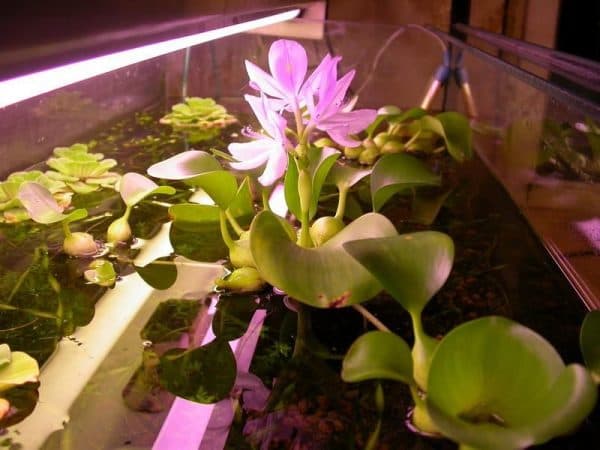

Escapes water hyacinths, sometimes reaching two meters in length, creep and stay on the water thanks to the porous fleshy base of the leaves. When this spherical bulge is cut with a diameter of 4 to 9 cm, its spongy tissue filled with air is visible. Such a float keeps leaves and flowers on the water surface, despite the heavy rootcompletely submerged under water.Powerful black root can grow up to 1 m in length.
If the depth is great, the plant floats in the center, and in shallow water it takes root in silt. Blooms usually in August. One eichornia of blue, pale pink, lilac or dark lilac shade can bring up to 35 fragrant flowers, but their standard is 6-7. Unfortunately, you can admire their beauty for just a day. But when there are many flower stalks, and they are constantly blooming, the process is mesmerizing.
Description of the species, photo, characteristics and flowering time of water hyacinth
Eichornia thick-stemmed or water hyacinth belongs to the class of Monocotyledons of the Pontederia family. You can find a mention of this plant under the names "beautiful eichornia" or "excellent".
It is a perennial herb with shiny leathery leaves up to 20 cm long, having a rounded or elliptical shape. They are assembled into a socket, inside of which a "pillow" of air is formed, due to which the water hyacinth is kept on the water.
The roots of the culture can reach 60 cm in length. If the depth of the reservoir where the eichornia grows is less than 50 cm, then the plant will not swim, but will take root in the muddy soil.
The stems of the plant reach 10-15 cm in length, and about 12-15 buds are formed on each of them, from which flowers with a diameter of 2-3 cm bloom. They come in different shades: white, pink, blue or lilac. Their lifespan is only one day, after which they hide under water.
In order for the water hyacinth to bloom, a temperature of at least +28 degrees is required. When the indicator drops to + 22, flowering stops. In a cold summer, buds will not appear at all, and only a lush "cap" of green foliage will float on the surface of the water.
Features of growing eichornia in an aquarium
Spacious aquariums are suitable for water hyacinths on a permanent basis or during the overwintering period. The main thing is that there is enough light, warmth and an abundance of macronutrients. To grow eichornia in aquariums, you will need to install lamps and an oxygen aerator. It is important that the plant does not reach the lighting fixtures with leaves, otherwise it will burn out, respectively, the container does not need to be filled with water to the brim, it is required to leave about 30 cm to the top.
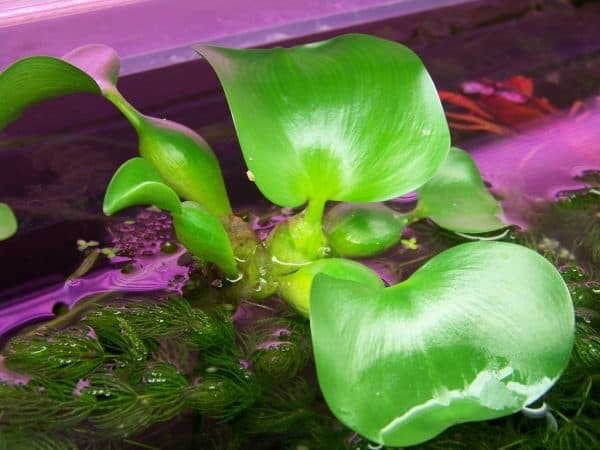

Hyacinth needs organically saturated water, obtained by adding peat and sand to the bottom soil, as well as populating an artificial reservoir with living inhabitants. To root eichornia, you will need at least 10 cm of soil, but the plant lives well even with free swimming in the water column. When kept at home, water flowers require:
- temperature regime - not lower than +23 and up to + 28 ° С, and for the flowering period you need to raise it by another 2 degrees;
- acidity - from 6.2 to 6.8 pH;
- additional lamp with a power of 3 kW / cm 2;
- daylight hours for 12 hours;
- calm stagnant waters without drafts.
Subject to the conditions, water hyacinth grows extremely quickly, and in order to control growth, it is recommended to cut off the processes coming out of the leaf axils in a timely manner, and periodically plant large ones. Growing in aquariums requires regular fertilization of the plants.
How to care
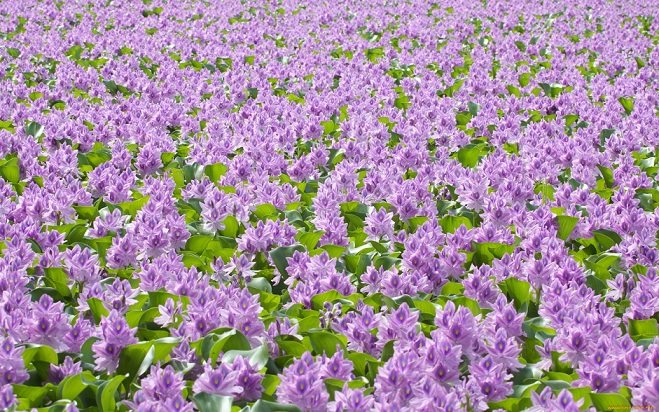

Let's find out what care the eichornia needs when growing it in a pond or aquarium.
Temperature
It is very important, as already mentioned, to maintain the optimum temperature of water and air. If it drops below +24 degrees, it is fraught with loss of health for the plant, the ability to bloom and develop. Note that a water hyacinth can survive at a temperature of + 10-20 degrees, however, there will be no flowering in this case.
Lighting
For normal life, a water hyacinth needs a lot of light: the duration of daylight hours should be at least 14 hours.
Pruning
Do not forget about pruning the plant, as hyacinth multiplies quite quickly. It is especially important to remember this procedure when growing in an aquarium where fish also live. If the flower grows strongly, there will simply be no room for the fish.
To prevent strong overgrowth, it is recommended to immediately remove the resulting horizontal shoots. Remember that the trimming procedure is performed only with gloves, since the juice of water hyacinth has poisonous properties, it can cause skin irritation and allergic reactions.
In the summer, pruning of dead leaf stalks is also required, since otherwise the reservoir will quickly become clogged. It is easy to understand which of the petioles are dead: they stand out against the background of the main foliage with a dark color and lethargy. Also thin out the plantings from time to time, since the eichornia grows irresistibly in favorable conditions.
Top dressing
Water hyacinth will develop well and bloom only in “fertile” water, saturated with nutrients. To fertilize the water, it is recommended to regularly add the following substances to it:
- compost;
- mullein;
- complex minerals for aquarium plants;
- silt
When you move the plant to a new pond, add some superphosphate to the water.
Water hyacinth for outdoor ponds
Although water flowers are considered exotic, they are not uncommon for ponds in our countries. They take root well both in natural and artificially created reservoirs. Eichornia are planted in the southern regions in May, and in the north - in early summer. For the development of a plant, the following are important: a high temperature index, long-term illumination and an organically saturated reservoir. However, warm sunny summers do not always fall out.
If a young hyacinth is purchased, any open pond will do, preferably with algae and fish. It is undesirable to plant in a clean reservoir - the plant will not have enough nutrition. Bottom sludge, mineral additives and humus are important in the spring, and in summer there is no need for additives - insects and plants get into the water, as a result a nutrient medium is created.
The flower does not require special care - you only need to cut new shoots so that the plant does not occupy more than 50% of the entire reservoir.
Biochemical laboratory
According to modern data, in eichornia, in the area of the villi of its roots, redox reactions take place, in which the root system of the plant participates, providing oxygen to aerobic bacteria in this zone, which carry out this biochemical process. Thus, the principle of extracting nutrients by eichornia from water contaminated with toxic compounds takes place as in a biochemical laboratory, which processes complex high-molecular and low-molecular products of human activity into harmless elements of the periodic table.
Reproduction of eichornia
At subzero temperatures, eichornia can only exist in peat aquariums, winter greenhouses, or in pots with constantly moistened peat. A plant is placed in a container, water is poured there or watered regularly. Sometimes, you can use a garden mixture of sand and earth instead of peat. It is necessary to place the plant in a warm environment and maintain at least 11 hours of lighting - for example, put the container on the windows on the south side.
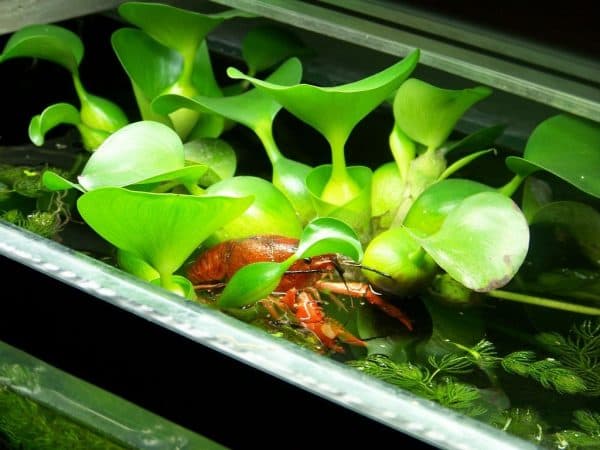

For overwintering at home, it is required to leave the plant only with a long, at least 10 cm, healthy root, so that there are chances to keep the hyacinth alive until summer.
Cold, illness, too dry indoor air can lead to the death of a floating flower. The plant must be timely transferred to the best conditions and provide it with sufficient water and light. Otherwise, the leaves will first darken and die.
Eichornia reproduce vegetatively, forming shoots similar to strawberry ones. The breeding process under good conditions is rapid.Growing from seeds did not find a response, since in more northern climates the seeds do not have time to ripen.
Important!
It is not recommended to breed an excellent eichornia in large quantities, since the plant has the ability to braid the pond / aquarium so tightly that air will not get there well, and aquatic inhabitants, be it fish or algae, will not be able to exist normally. The edges of the eichornia leaves are delicate and wavy, which gives a special aesthetic appearance to the plant. It feels great in warm and calm places. Provided a suitable environment, this representative of the flora can turn into an almost constantly blooming and perennial inhabitant.
How to overwinter a water flower
Not all water hyacinths can survive the winter even at home warm conditions. Many people notice that immediately after moving to an aquarium or greenhouse, the leaf plates begin to turn black, and the plant dies, although all the conditions for the flower are met. This means that the Eichornia was removed too late, and she had time to freeze.
To prevent this from happening, you should not wait for coolness - better sooner than later.
With the first signs of a drop in air temperature to + 15 ° C, it is recommended to take the plant into a warm place.
Even if the decrease occurs only at night, there is no need to take the eichornia to "warm up" in the pond during the day - this is a serious stress for the plant.
You need to remove the eichornia in an aquarium filled with water in which the flower lived, and put it in a place prepared for it. It is impossible to have heating devices nearby - this will dry out the leaves. Do not close the container with a lid either.
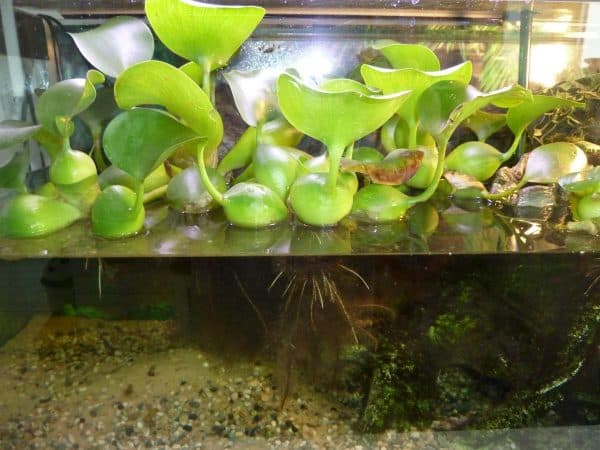

Water hyacinth, like a pump, is able to quickly suck out all harmful substances from the water, so people like to plant it in their aquariums and ponds as a natural purifying filter. It is able to absorb even oil products - for a plant it is a nutrient medium, and it copes with filtering functions, improving the condition of water even in abandoned reservoirs.
If for someone a floating flower is a "green plague", then in other places it is a beautiful and original decoration that is of great benefit.
Reproduction of the water hyacinth of Eichornia
Usually, water hyacinth in a pond can be propagated vegetatively by separating young rosettes from mother plants. An increase in mass in eichornia occurs with a decrease in the duration of daylight hours, which can be used to collect planting material.
If, in addition to the water hyacinth, as in the photo, there is other vegetation, fish, amphibians or mollusks in the reservoir, excessive reproduction of Eichornia can lead to a change in the level of illumination and oxygen in the water, as well as to the death of flora and fauna. Hyacinth also propagates by seed. But for their ripening, an air temperature of at least + 35 ° C is required, which is practically unattainable in most regions of Russia.
Eichornia - Water Plague
Back in 1884, the organizers of a cotton exhibition in Texas to attract visitors, in the center of the hall, in a small pool, placed outlandish plants brought from Venezuela, the emerald green leaf rosettes of which were decorated with blue racemose inflorescences, reminiscent of everyone's favorite hyacinths.
Visitors to the exhibition were eager to purchase exotic items for their ponds and pools. In addition, as it turned out, these plants multiplied surprisingly easily and quickly.
Happy owners of water hyacinths presented luxurious flowering specimens to their relatives and neighbors.
Due to the amazingly high rate of vegetative reproduction, the plants that soon did not find their owner found themselves in natural reservoirs of Florida, where they began to grow incredibly quickly, this was facilitated not only by the warm climate, but also by the complete absence of natural enemies.
In tropical fresh waters eichornia have a very high growth rate and, propagating vegetatively, are capable of covering the surface of the reservoir with a continuous layer of green mass in a short time. Because of this feature, residents of regions where there is a riot eichornia, call this plant water plague.
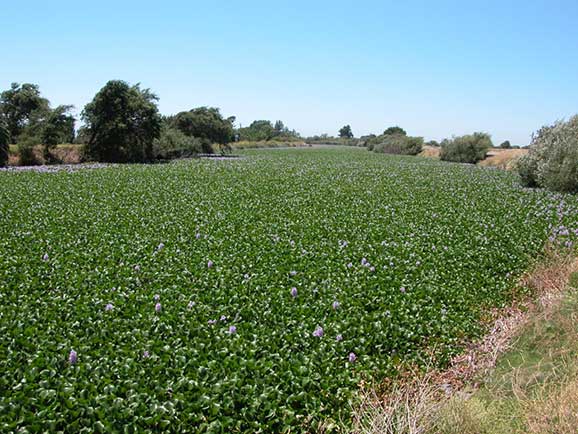

Eichorniae have a very high growth rate and are able to cover the surface of the reservoir with a continuous layer of green mass in a short time.
From a delicate ornamental plant, water hyacinth has rapidly turned into a malicious weed, filling all reservoirs with lightning speed.
Soon, millions of plants covered the once clean surface of many rivers and lakes, completely depriving the local flora of access to sunlight, causing disruption of gas exchange, especially in stagnant water bodies, as a result of which native species were doomed to death. Insects disappeared from local water bodies, followed by fish.
The huge mass of plants floating on the surface of the water impeded navigation. The Florida authorities were not ready for such an invasion: the Florida rivers were slowly "dying".
As a matter of urgency, special machines were designed and manufactured - draglines, outwardly very similar to a walking excavator. Being on the shore, the dragline takes out its long arrow in the middle of the reservoir, capturing thousands of plants and folding green mountains from them on the shore. Later, the green mass was transported on trucks for composting, as a result of which silage was obtained for livestock feed, and organic fertilizers. Only in this way was it possible to contain the onslaught of water hyacinths.
The story did not end there, because eichornia not limited only to the reservoirs of Florida, but began to develop the rivers and lakes of other southern states of the United States, moving further and further north, only cold winters could stop the green aggressor.
A similar situation has developed on other continents. In 1954 one of the French officials brought a single specimen of water hyacinth to the Congo. And 20 years later eichornia became a real disaster for many rivers in Africa, filling their channels.
The waters of the Congo sometimes carry huge green islands, capsizing boats, plugging the estuaries of tributaries, causing floods. A similar situation has developed in tropical Asia and Australia.
At one time, it was believed that the unlimited growth of weeds could be prevented by animals. So in Africa, high hopes were pinned on hippos. However, even these formidable plant lovers fell short of expectations - spreading speed eichorny significantly exceeded the rate of its eating by hippos.
From the Congo Basin eichornia got into Lake Malawi, where it was discovered in the 60s of the last century, now this plant is found throughout the lake and its tributaries. But in the hard and nutrient-poor water of the lake, the rate of its growth is relatively low, and the plants carried out by the current flowing into the lake, the plants gradually die, but in the rivers themselves eichornia feel great, as evidenced by their rapid growth, which creates problems for local hydroelectric power plants.
All this could have been avoided if not for the usual human frivolity.
This raises a reasonable question. Why in their historical homeland eichornia does not bring such troubles?
In the Amazon basin, water hyacinths grow just as quickly, but their spread is hindered by other types of biocenosis that have formed for thousands of years near eichornia... So its shoots feed on manatees (river cows), many local herbivorous fish and freshwater molluscs. In addition, there are several types of insects that specialize exclusively in eichornia... And finally, powerful regular floods, characteristic of those places, carry green islands of water hyacinths into the ocean, where they die in salt water.
Neither North America nor Africa has natural enemies eichorniaand the floods are not that strong. In addition, the ecological niche occupied by these plants turned out to be free.
Mechanical methods of struggle, such as mowing, pulling and extracting from the water, do not give tangible results.
The situation could be improved by the use of herbicides sprayed from airplanes or special ships, but unfortunately there are no selective herbicides yet, and the use of others has a negative impact on the environment. Therefore, their use is generally prohibited.
More recently, American scientists have begun to acclimatize the manatee in the waters of Florida. This sluggish aquatic mammal grazes all day in overgrown pastures eichornia... Perhaps the manatees will help curb the green aggressor.
To combat over-proliferation eichorniaalso use the weevils Neochetina spp, which are their natural enemy as they feed exclusively on this plant.
Using water hyacinth in landscape design
This amazing plant is the personification of warm and humid tropics, its beauty has found application in almost all countries of the world. The tenderness and fragility of inflorescences, attractive leaves will harmoniously fit into any garden design.
This plant will also look an interesting bright spot in a home aquarium. The most important thing in caring for him is constant monitoring of his growth. In all other respects, this amazing plant fully justifies the name given to it - beautiful eichornia.
Unusual application
In the 80s, eichornia was considered a weed and was destroyed in many bodies of water. Over time, scientists were able to determine its unique properties for wastewater treatment. It was first used at a poultry farm in the Vladimir region. Water hyacinths were planted in artificial reservoirs and after a week the specific smell disappeared.
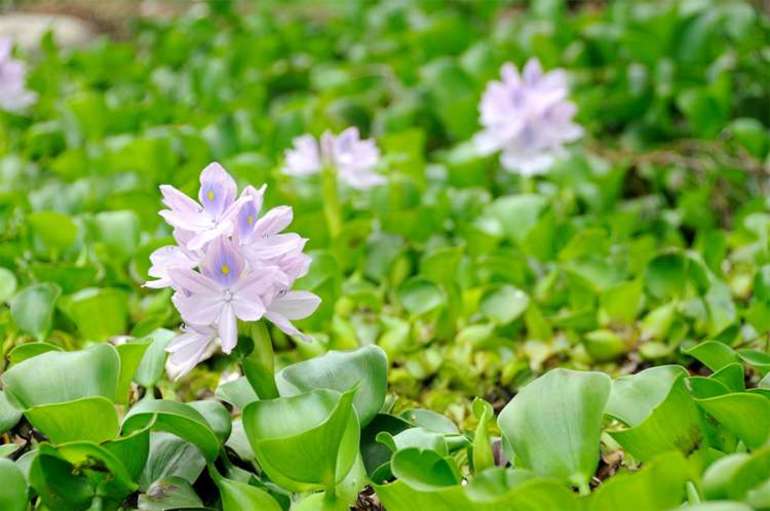

After that, experts conducted tests, which showed that 80% of the bacteria were destroyed by eichornia. Another advantage of this cleaning method is the significant cost savings. In the case of traditional waste disposal options, the poultry farm would spend a lot of money.
Experts believed that the plant was able to cope with industrial wastewater, but so far this technology has not become widespread. In Asian countries, eichornia leaves are used as an additive in livestock feed.
General points about water hyacinth
Tropical reservoirs of South and Central America are considered homeland. Now, thanks to its decorative qualities, it has spread not only to the warm waters of Africa, Asia and Europe.
But now it can be found in natural reservoirs of central Russia and in aquariums, a fish lover.
Eichornia water hyacinth - what is it
With this aquatic plant covering the water surface, the chemical composition of the water can be improved well.
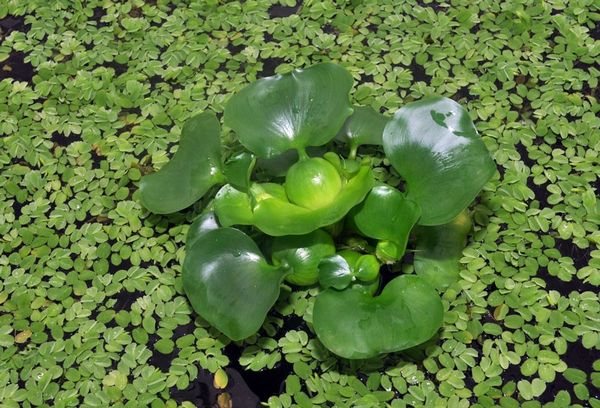

Water purification is achieved through large-scale coverage of the surface of reservoirs
Pet removes hazardous elements from water:
Description
The sheet plates are assembled into a socket. The base of the leaf plate is widened inside this expansion is a tissue that allows this aquatic plant to stay on the surface of the water.
Long fibrous roots submerged in water 50 cm... It blooms with amazing flowers similar to Hyacinth with various shades:
Flowers begin their dissolution at the end of August.
How it grows in an aquarium
In an aquarium, growing water hyacinth is very troublesome and requires certain skills. The flower is placed in the water so that the roots touch the ground, and the plant itself floats on top.
The soil in the aquarium where the water hyacinth is grown, should be made of sand.
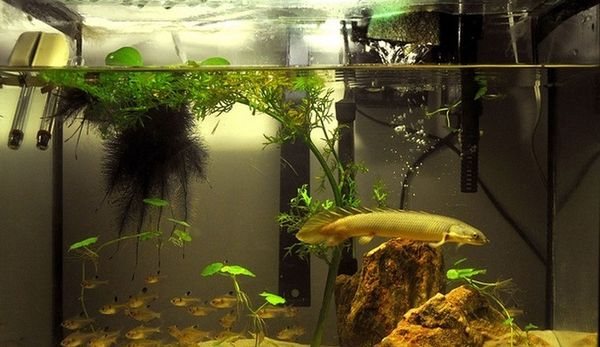

The soil for the aquarium with eichornia should be sandy
The temperature of the water in the aquarium is kept at 25 degrees and lighting is needed for 12 hours. It is good if the sun's rays fall on the aquarium for a couple of hours a day.
Also, fertilizers for plants living in water are introduced into the water throughout the year. The flower needs aeration of the water so that it does not manifest putrid smell of water.
There are also flowers that can be planted near the aquarium. For example, aquarium fish can feed on Tradescantia that gets into the water. This is one of the points on the list of facts about the Tradescantia plant and its homeland.
How it grows in a pond or body of water
There are no particular problems with growing in a summer reservoir. It is planted in a reservoir in May-June, and it quickly covers the surface of the water. It is only necessary to restrain rapid growth by removing lateral shoots.
At the same time, be careful, since the juice of the plant may irritate the skin of the hands... Therefore, all pruning of shoots is best done with rubber gloves.
With the onset of a cold snap, it is necessary to monitor the decrease in temperature, as soon as it reaches 10 degrees Celsius, Eichornia should be sent to winter. Each gardener chooses the method of preservation himself.
Characteristics of the species
Aquatic Hyacinth is a valuable plant that has been used by humans. It is not only a water vacuum cleaner, but also a great pet food. It belongs to its own species and its Latin name is Eichhornia crassipes.
Eichornia is an excellent feed for cattle
According to foreign sources, eichornia is an excellent feed for cattle, sheep, goats, rabbits, pigs and poultry. Studies have shown that one ton of green mass of this plant contains up to 60 kg of potassium, 21 kg of nitrogen, 17 kg of phosphorus and up to 26 kg of protein with a high content of essential amino acids and vitamins. Foreign authors give examples of a positive effect on the productivity of different animal species from 15 to 10% of the green mass of eichornia in the diet.
In an experimental farm on older chickens, which already showed a significant age-related decrease in the level of egg production, an experiment was set up to study the effect of adding eichornia green mass (10 g per 1 chicken) to stimulate productivity. Were planted in separate cages, 45 pairs of analogous chickens, some of which received only standard feed (control), and in the experiment - the addition of eichornia to it. 12 days after the start of feeding the Eichornia, they began to record the number of laid eggs and determine their weight in both groups; the experience lasted for 8 days. In the experimental group, one chicken received 1.46 eggs more than in the control, while the average egg weight was 1.46 g higher. The results of the industrial experiment confirmed the positive effect of the green mass of eichornia on the productivity of egg hens. After that, in the experimental farm, all laying hens received eichornia in feed, while a consistently high egg productivity of the livestock was observed (up to 94% at the peak of the main herd). Under the conditions of an experimental farm, production tests of effective modes of biotechnology for growing eichornia in bioponds (open and greenhouse) are continuing. There are also studies of the quality of eggs and meat obtained from poultry, in the diet of which this promising crop is constantly present. Since a number of indicators of the content of nutrients in the green mass of eichornia and the characteristics of the water of bioponds today do not have domestic standards, special attention should be paid to the biosafety of such enterprises. Eichornia is great for use in landscaping.
Features of Eichornia the beautiful
The plant is unusual, even for other aquatic crops. In comfortable conditions, water hyacinth can grow with incredible speed, covering the entire surface of its native reservoir with its leaf mass. Because of this, difficulties often arise for fishing, the construction of hydroelectric power plants, the passage of ships on water, etc.
The depth of the reservoir does not matter for the growth of the hyacinth, it can grow anywhere.In very deep water, the plant floats, and in shallower water it takes root in shallow water or in a muddy bottom.
Its roots have cleansing properties, the effect extends to nitrates, phenols, phosphates, heavy metals and many other harmful compounds, often discharged into various water bodies. When kept in an aquarium, it prevents salt build-up.
It is not worth planting water hyacinth in large quantities, its overly rapid development leads to the fact that the tightly braided surface of the reservoir will not be able to pass air, as a result, all aquatic inhabitants will begin to experience great breathing problems.
This aquatic inhabitant feels great in calm and warm places, it is here that he will turn into a perennial plant that blooms most of the year. For example, an aquarium could be such a place, where hyacinth will also contribute.
Possessing absorbing properties, it perfectly cleans water, destroys unpleasant odors and makes it crystal clear.
Experienced aquarium owners recommend abandoning the purchase of expensive filters, and planting an eichornia, which will perfectly cope with this task. It will absorb poisons, fish waste products and other toxins. Hyacinth is a good organic fertilizer that contains a lot of vitamins and minerals.
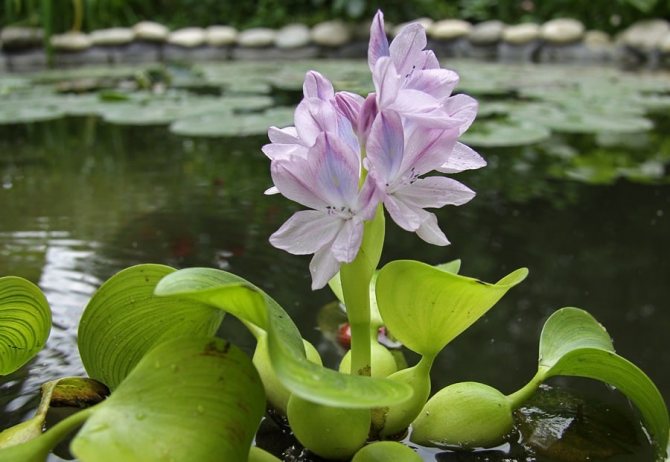

Types of eichornia
Varieties of representatives of the genus Eichornia differ from each other both in appearance and in growing conditions.
Azure
This type of water hyacinth can grow both underwater and on the surface. The height of the main stem reaches 60 cm. The upper leaves, which have a rounded configuration, reach a length of 8 cm. The lower leaves are narrow and elongated, pointed towards the ends. Their length is up to 15 cm.
The inflorescence is large, the number of flowers in it reaches 12. The decorative properties of this variety of eichornia are at a height: in the aquarium, it creates a bright, exotic background for the fish living in it.
Eichornia azure is whimsical and requires the following conditions:
- water hardness - from 2 to 16 ° W;
- temperature - + 18 ... + 30 ° C;
- the optimal pH level is from 4 to 7.
Filtration and regular, once a week, replacement of 25% of the water volume are necessary.
It is recommended to use sand and clay as a soil for planting. Eichornia azure should not reach the surface of the water, so the stem will have to be trimmed from time to time.
The preferred daylight hours for this species are at least 12 hours, and the light should be bright.
Variegated


Eichornia is variegated.
Unlike other types of water hyacinth, eichornia varifolia is characterized by the complete absence of the upper part. Eichornia varifolia grows only in the water column. The stem length of this culture reaches 50 cm in height.
This plant variety is unpretentious, gets along with other inhabitants of the aquarium. The optimal planting site is in the back of the aquarium. This will create a beneficial backdrop for the fish thanks to the thicket effect.
The main condition for which this species is demanding is clean water. The soil for variegated eichornia can consist of coarse sand and pebbles. The optimum temperature is 28 ° C degrees, pH is 6-7, water hardness is up to 6 ° J.
Tolstonozhkovaya
This type of water hyacinth is the most common and has earned the name "Eichornia beautiful" or "Eichornia excellent" - eichhornia crassipes. The plant has short stems on which rosettes of heart-shaped leaves are located. Filiform roots. The petioles are filled with air, which ensures the retention of the plant on the water surface. Eichornia beautiful flowers have a pink-lilac coloration. Flowering lasts 1 day, after which the peduncle is immersed in water.
To cultivate this variety, the temperature must be above 14 ° С, optimally + 26 ... + 30 ° С. The pH of the water is neutral or close to neutral.In order to provoke flowering, the water temperature must be even higher: + 30 ... + 33 ° C.
Reproduction of eichornia fine occurs by separating daughter rosettes, as well as by cutting the rhizome.
Features and difficulties of growing
Eichornia excellent can grow well in a pond on a personal plot, if you create suitable conditions for it. Despite its exotic origin, this plant does not require special care. The main thing is that there is a lot of organic matter in the water.
The growth of a flower directly depends on nutrients, so it is useful to add to the water:
- mullein;
- compost;
- complex formulations and mixtures for feeding aquarium plants.
Excellent for growing eichornia water with a slightly alkaline reaction. The plant is not at all afraid of harmful impurities, even destructive for other crops.
Eichornia roots are very strong, powerful, and absorbing nutrients well, they process harmful components along with them. Very often, water hyacinth is used for cultivation in sedimentation tanks to purify water.
We must not forget that water hyacinth is very thermophilic and loves bright sun. Therefore, you need to plant a flower in the spring so that it has time to take root well before the onset of the first cold weather. The culture is very difficult to tolerate temperature changes.
Home and outdoor care
In order for the fruit to grow, it is necessary to recreate the natural conditions as accurately as possible during care. Namely:
- lots of sunshine. In the shade, the stem can multiply, but the inflorescence may not open;
- a large amount of nutrients;
- high air temperature. The lower the temperature, the worse the plant feels. Ideally, if the thermometer is the same as in the tropics, this is the only way to save the life of the hyacinth.
Important! Humus and compost are ideal fertilizers.
How to preserve eichornia during cold weather
Keeping water hyacinths at home is no easy task. There are four ways to preserve it until the summer heat:
- caring for a home hyacinth in an apartment is not so troublesome if you keep it in the silt. To do this, fill the pot with water and fill the bottom with silt. Put a pot and periodically monitor the water level;
- you can store the plant in the winter in a regular glass jar. To do this, fill a clean jar with one third of clean water. Tightly tighten the lid and put on the window at room temperature;
- The easiest way to overwinter is to store your water hyacinth in the sand. To do this, it is necessary to fill the contents of the container with sand, moisten it enough and constantly maintain the required water balance. Special conditions in the form of lighting, fertilizers and temperature are not required;
- The most time consuming way to store a plant is to overwinter in an aquarium. But if you understand all the difficulties and small details, then this is the most reliable way to preserve hyacinth.
Important! The water in the aquarium should be from the same reservoir where the eichornia grew. It will not be superfluous to carefully prepare and collect silt from the bottom of the pond where the plant grew. In order for it not to rot, plant it so that only the root touches the water.
Thus, water hyacinth is an exotic plant that, with proper care, will delight the owner with its beauty and original look of the decorated body of water. The main thing is to follow all the recommendations for growing and care.
Nutrition and fertilization
The more organic residues in the water, the more food it contains for aquatic plants and the more luxuriantly the water hyacinth grows, forming luxurious thickets on the surface. During winter storage under greenhouse conditions, fertilizer for aquarium plants or a drop of common flower fertilizer can be added to the water.
Practical application of eichoria.The positive properties of the plant include its ability to absorb insecticides, phenols, phosphates, and absorb heavy metals (cadmium, nickel, silver). Due to these properties, the plant is often used for post-treatment of treated domestic wastewater at sewage treatment plants in countries with a warm climate (in countries with a temperate climate - in warm seasons). It can be used as organic fertilizer, raw material for biogas production and for livestock feed. It is often used as an aquarium plant. Hyacinth is also good as an organic fertilizer, as it contains many minerals and vitamins.
sunlight
If you provide the right care for such a plant as water hyacinth, then it will delight you with beautiful flowering. It is not difficult to create comfortable conditions for culture.
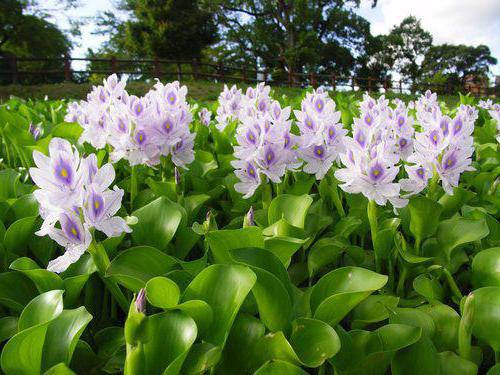

Remember initially, Eichornia loves sunlight. Therefore, it is better for her to choose lighted areas in fresh warm waters. Although the plant is able to perfectly exist even in a shady area. However, for beautiful flowering, she just needs an abundance of sun.
When doing this, try to avoid drafts. Their plant simply does not tolerate. And it may even die.
Wintering plants
As soon as the air temperature begins to drop, the plant must be moved to a warm room. Eichornia can overwinter:
- in the pelvis;
- aquarium;
- suitable transparent container.
The vessel should be filled with the same water in which the culture developed in the summer. It is recommended to add a little sludge to the container. This will allow the plant to take root and winter comfortably.
So that the water hyacinth does not die at home, the following points should be taken into account:
- The plant no longer needs high temperature. But it is still necessary to provide warmth. Optimum performance is 20 ° C.
- Hyacinth rosettes are very sensitive to lack of light. It is recommended to install a backlight above the container. This will allow you to get through the winter normally. Eichornia should receive light for at least 14 hours a day.
- The plant needs warm water. The liquid temperature should be around 20 ° C.
- Provide fresh air for your culture. However, do not forget that she cannot stand drafts.
- Monitor moisture levels carefully. Evaporation of water can kill the plant. Therefore, you should periodically add water.
- To protect the hyacinth from starvation, it is recommended to add a little fertilizer. Use special formulations for aquarium plants.
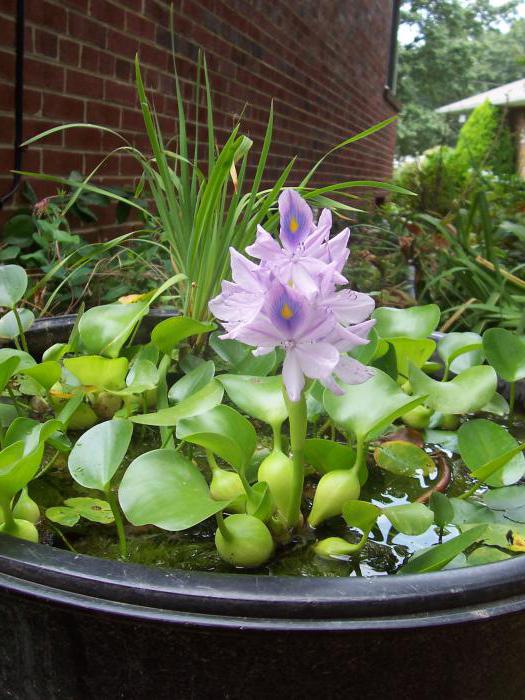

Water hyacinth can be a wonderful decoration for a pond. It will delight you with a special, magnificent spectacle during flowering. However, owners should be aware of the significant disadvantage of the plant. In favorable conditions, it is able to multiply rapidly. Covering the pond with a "thick blanket", the culture can lead to the death of many inhabitants of the pond. Therefore, the plant should be thinned periodically.
An unpretentious plant of natural and artificial warm reservoirs - water hyacinth - can feel equally good both in aquariums and in natural habitat. Reproduction and planting of water hyacinths are available even to inexperienced amateurs. He began his triumphant march across countries and continents from the subtropics of South Africa. There eichornia (this is the second name of the perennial) felt well in small stagnant bodies of water. Water hyacinth forms rosettes of bright leaves on petioles on the surface of the water, ending at the base with voluminous cavities filled with air.
During the flowering period, amazing flower stalks are formed on it, resembling orchid flowers in shape and color. Despite the name, eichornia does not belong to the hyacinth family, it's all about the similarity of the flower arrow with the peduncles of the plant of the same name.
The extraordinary vitality of the water hyacinth and its ability to reproduce in the shortest possible time became a real disaster in those parts of the world where it got artificially and where there are no insect species that naturally regulated the number of the invader of the water area in the region of its origin. The indisputable advantages include its ability to purify water from harmful impurities, as well as the fact that perennials require minimal care. Water hyacinth can even sanitize water bodies at sewage facilities.
Plant care requirements
For this plant, the main condition is availability of water with a suitable warm temperature and light.
Landing
For engraftment, the water temperature must be at least 25 degrees Celsius. Therefore, it is planted in an artificial reservoir when the threat of return frosts has passed.
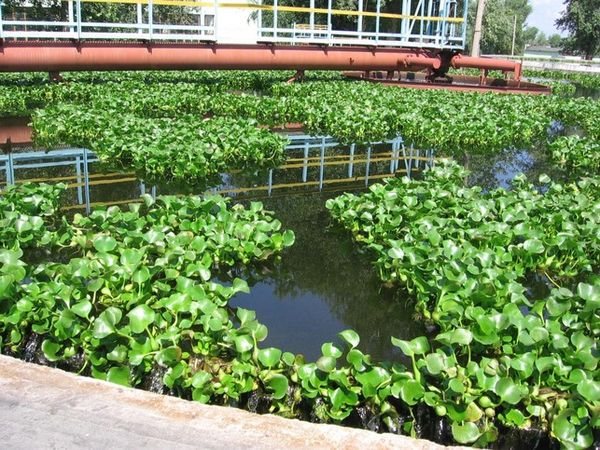

Disembarkation is allowed only during the warm season, when there is no risk of water freezing
In order for the plant to grow well and reproduce in its reservoir need to feed... It has a large, fibrous root system that filters water and the flower needs nutrition to live and reproduce in warm water.
Therefore, various fertilizers will need to be added to the water:
- Sodium humate.
- Natural sludge.
- Rotted manure.
In clean and fresh water, water hyacinth will not grow, and may even die from a lack of nutrients.
If the plant is planted in an aquarium, it must be used special fertilizers for the aquariumso as not to harm the fish living there.
How to keep at home in winter
The flower will not be able to endure winter in the conditions of Russia, even in its south. Therefore, a part is taken out and put into storage.
Storage options
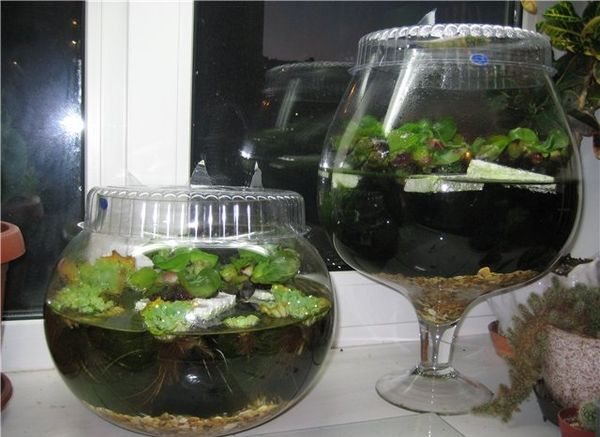

In the cold season, there is a certain procedure for overexposing plants.
In wet sand
A container of at least 10 liters is selected and sand is poured onto its bottom from the reservoir where the plant grew in summer. Then water is poured from the reservoir and the specimen is planted so that its root system can reach the sand, but does not lie completely on it.
If during wintering the plant sheds its foliage, then it is clearly not enough lighting.
In the silt
If wintering in water is not suitable, then you can winter in silt. To do this, the container is filled with silt half, where the flower is planted. In this case, it will be necessary to constantly maintain the moisture content of the sludge so that the water exceeds the sludge level by 7 cm.
Wintering in the water is most suitable for Eichornia.
In a three-liter jar
Take a three-liter jar or other container and fill it with water. The air temperature in the room where Eichornia grows should not drop below 20 degrees Celsius.
Since there is very little light in winter, an aquarium lighting or another lamp is placed above the container and turned on so that the daylight hours are at least 12 hours. With such a wintering, fresh air is very much needed, but not a cold draft.
This beautiful flower may well decorate a pond with its appearance. The main thing is curbing growth... And then, in the very August heat, the water hyacinth will delight with its flowering those who will rest near the reservoir.
Description of the plant
Hyacinth is an aquatic floating perennial plant native to the United States. In another way, it is called "Eichornia". It is most commonly found in the swampy areas of the Amazon. But now water hyacinth is distributed all over the world. The plant mainly grows in the tropics, on the surface of water bodies - rivers, lakes and ponds. In addition, it can even be grown both in an aquarium and in decorative ponds.
Under favorable climatic conditions, hyacinth grows very quickly. This interferes with shipping, which is why the plant is often called water plague.
Hyacinth has swollen petioles on which the plant is kept in the water. These petioles contain air and are entirely composed of honeycomb fabric.Calmly stand a lush emerald rosette, from the center of which flower stalks depart. The leaves of the plant are oval, dense and wrinkled. Up to 10 leaves can be counted on one flower. The root system is fibrous and can reach up to 0.5 m in length. The rhizome of water hyacinth has a unique property: it is able to purify water from phosphates, nitrates, heavy metals, phenols and other harmful impurities.
Flowering lasts all summer, with each flower blooming for only 2 days. However, due to their large number, flowering seems to be long and plentiful. Hyacinths bloom especially beautifully and brightly in non-rainy and warm weather.
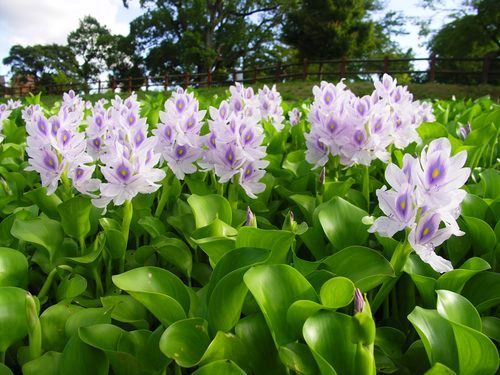

The peduncle, after it has faded, goes under the water. If the summer turned out to be cold, then a huge cap of emerald dense foliage appears over the water surface. Due to the dense vegetation layer, the oxygen regime of water bodies deteriorates. This can lead to the death of other aquatic plants, while the reservoir itself acquires a very unpleasant odor. This phenomenon is usually observed in the homeland of the water hyacinth.
Eichornia harvest all year round
The farm "U Samvela" is considering the option of rational use of the harvest of eichornia all year round with the introduction of biotechnology of silage of green mass in the phase of the greatest accumulation of protein and other biologically active substances in plants. For the climate of the southern regions of Ukraine, these are the last months of summer and the beginning of autumn (August-September). The chemical composition of the plant mass of Eichornia can vary significantly depending on the growing environment and the age of the plants. In the open biopond of the farm "U Samvela", where during the summer a crop of 151 kg of green mass of Eichornia was grown from 1 square meter of water surface, and the remaining bottom silt was used in autumn to fertilize fields with winter wheat. The results of laboratory analysis of the chemical composition of green eichornia plants, made in different summer months, show that during the season, protein accumulated in green eichornia plants, the amount of which, according to laboratory chemical analysis, significantly exceeded the level of such traditional fodder crops as corn and even alfalfa. In terms of nutritional value, the green mass of eichornia is comparable to concentrated feed (0.88 feed units), while it is eaten by animals with appetite and is saturated with biologically active growth-stimulating substances.
The use of a hydrobotanical method for purifying livestock wastewater allows you to create a system of closed circulating water supply to an agricultural enterprise. The cleaning process can take place all year round, since the rhizome, stems and leaves of eichornia can function under certain conditions in the autumn-winter period, which is typical for the biotechnology of using eichornia in an experimental farm.
Requirements for modern conditions for environmentally safe livestock management provide for strict control of feed raw materials at all stages of feed production. For this reason, taking into account the biological characteristics of the cultivation of eichornia as a hydromacrophyte plant in water with dissolved organic matter in the form of faeces of animals of various species, the farm "U Samvela" carried out constant monitoring of the total toxicity of green mass and raw materials-substrates using express biotesting on ciliates Colpoda steinii (in accordance with the current interstate standard GOST 13496.7-97). Research data show that although organics for plant nutrition (feces of chickens) had a pronounced toxicity, but after additional biotreatment on the farm and transformation into a green plant of Eichornia, feed raw materials became harmless for model test objects and during biocontrol on macroorganisms.
In November 2019, experimental samples of silage were made from the green mass of Eichornia grown in a closed biopond at the U Samvela farm using biotechnology recommended by domestic ones (Ukrprolife, Chernihiv region). A feature of this plant is that it is possible to apply a resource-saving harvesting technology, that is, all parts of the plant are crushed and ensiled together with the roots. After that, the biopond is cleared of silt stocks, which is a good fertilizer, and the pond can be used for the next cultivation cycle of eichornia.
An assessment made by a commission of farm specialists based on the results of experimental ensiling 21 days after laying was found to meet the requirements for silage from green plants (DSTU 4782: 2007) in terms of organoleptic characteristics: greenish color, pleasant smell, no mold, rot or other spoilage.
Diseases
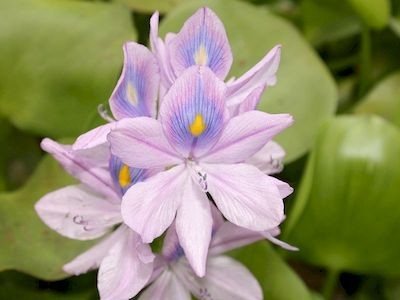

The plant is sick only from improper care or incorrect wintering. If the flower begins to wither, it needs to be provided oxygen flow and increase the period of artificial illumination... Organic matter, trace elements, silt and humus should be added to the water.
Eichornia is a flowering plant. Requires high temperatures above 25 ° C, sun and artificial lighting. Propagated by seeds and daughter processes. Prefers fortified water with a large amount of organic matter.
If you find an error, please select a piece of text and press Ctrl + Enter.
Flowering period of eichornia in natural and artificial habitat
Hyacinth - home care, growing in a pot
Water hyacinth belongs to the class of tropical plants. Like all plants of this type, he likes when a number of conditions exist:
- warm weather during the day and at night.
- a lot of light;
- a large amount of fertilizer in the water;
- presence of carbon dioxide in water
Important! The flowering and growth of hyacinth begins when all of the above points are present in the reservoir.
Flowering in natural conditions begins when the air temperature reaches 28 degrees during the day and at night the thermometer does not drop below 23. If the temperature is lower, the plant stops developing. Plant buds begin to bloom mainly in July and August. The life cycle of a flower is not long - a day. Then, the inflorescence is immersed in water, and a core with seeds remains in place of the bud.
Flowering in an artificial habitat begins in May and, in the presence of warm greenhouses, continues until September. The plant is not adapted to winter in the reservoirs of Russia, therefore, in the fall, when the temperature drops below 8 degrees, the eichornia must be removed to the greenhouse. You can take it out into an open reservoir when the temperature of the water and air is approximately at the same level and exceeds 15 degrees.
Note! At lower temperatures, hyacinth in open water can die.
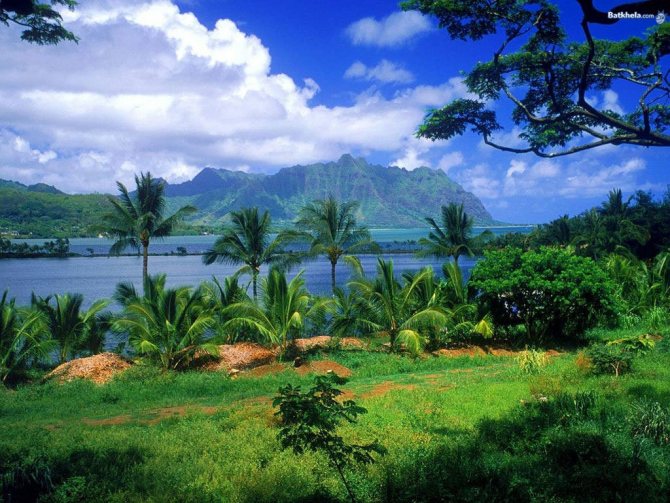

Tropical terrain
Eichornia as an alternative to cutting
In early spring, when primroses have not yet appeared in the forest, in the flower shops of Paris, along with the usual cut flowers, customers are offered water hyacinths, grown in large quantities in greenhouses.
Parisians love eichornia and they willingly buy them, together with special deep glasses in which they pour water and place the purchased plants. Glasses are placed on sunny windowsills.
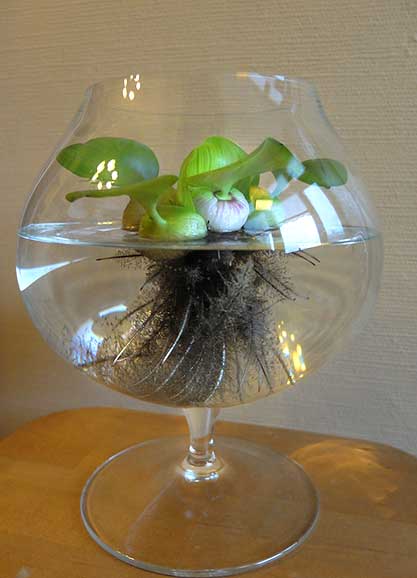

Soon at eichornia dense roots grow, and new leaves appear one after another. And now comes the time of flowering, when beautiful light blue flowers with yellow centers bloom. The blue color is characteristic of the natural form of water hyacinth.
Currently, breeders have obtained plants with pink, white and purple flowers.
The life cycle of a flower is limited to only one day, after which it withers and goes under water. The first is replaced by another flower. In nature, water hyacinths bloom almost continuously.
Unlike cut flowers, eichornia lives in a glass for a long time, besides, it does not need a substrate, it is enough to just add water.
It is interesting:
Water hyacinth is a versatile plant, suitable not only for purifying water and decorating the landscape. In some tropical countries eichornia grown as a vegetable crop and for the purpose of obtaining organic fuel.
Temperature regime
It should not be forgotten that the historical homeland of the plant is Brazil and South America, which have a hot climate. Therefore, Eichornia feels most comfortable in warm conditions.
In order for the plant to fully and correctly develop, it is recommended to listen to the opinion of experts:
- For the full development of the plant, a temperature of at least 22 ° C is required. With this in mind, the planting of the water hyacinth takes place in June.
- The optimum temperature for a heat-loving plant is 25-27 ° C. And during flowering - 28-29 ° C.
- The plant does not tolerate temperature extremes.
- When it gets cold, the hyacinth must be placed in an aquarium with water and transferred to a warm room.
- In winter, the plant can withstand temperatures of at least 15 ° C.
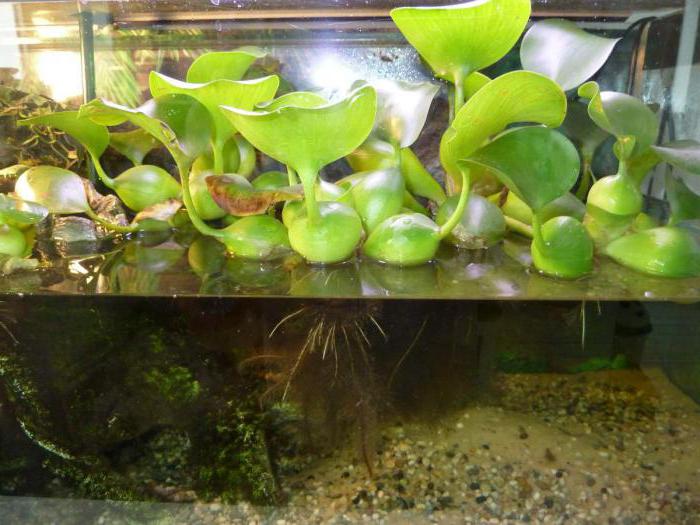

How to plant eichornia?
In its homeland, a perennial multiplies in 2 ways:
- separation of young outlets from the mother;
- seeds.
Since the seeds ripen at temperatures above + 35⁰C, planting in this way has no practical value for the regions of southern Russia and the middle lane.
In its natural habitat, seed reproduction of eichornia occurs as follows:
- after flowering, ripe seeds fall into the water from a spontaneously bursting seed box;
- in warm climates, seeds germinate and form many young specimens.
In cool water, seeds quickly rot and become unviable.
In a vegetative way, water hyacinth reproduces similarly to garden strawberries - by separating the "children" from the mother plant. Their growth is especially active during a decrease in daylight hours. In a month, this water "incubator" is capable of producing up to 100 daughter processes, which do not need scrupulous care at all. Planting the eichornia is not very difficult - the sockets are simply separated, keeping small roots on them, and placed in a new reservoir.
Separate daughter plants with gloves, as eichornia sap contains cyanic acid, which causes itchy skin.
The best time for breeding is early summer. If the optimal growing conditions are observed, the roots begin to grow at the young rosette, new leaves appear. The growth of the vegetative mass is more active if the water in the new reservoir contains impurities for the growth and development of a young plant - organic or mineral fertilizers.

